

Manufacturing Business Plan PDF Example
- May 7, 2024
- Business Plan

Creating a comprehensive business plan is crucial for launching and running a successful manufacturing business. This plan serves as your roadmap, detailing your vision, operational strategies, and financial plan. It helps establish your manufacturing business’s identity, navigate the competitive market, and secure funding for growth.
This article not only breaks down the critical components of a manufacturing business plan, but also provides an example of a business plan to help you craft your own.
Whether you’re an experienced entrepreneur or new to the manufacturing industry, this guide, complete with a business plan example, lays the groundwork for turning your manufacturing business concept into reality. Let’s dive in!
Our manufacturing business plan covers all essential aspects necessary for a comprehensive strategy. It details operations, marketing strategy , market environment, competitors, management team, and financial forecasts.
- Executive Summary : Provides an overview of the manufacturing company’s business concept, market analysis , management, and financial strategy.
- Facilities & Equipment: Describes the facility’s capabilities, machinery, and technological advancements.
- Operations & Supply: Outlines the production processes, supply chain logistics, and inventory management.
- Key Stats: Offers data on industry size , growth trends, and market positioning.
- Key Trends: Highlights significant trends impacting the industry, such as automation and localization.
- Key Competitors : Analyzes primary competitors and differentiates the company from these rivals.
- SWOT: Analyzes strengths, weaknesses, opportunities, and threats.
- Marketing Plan : Outlines tactics for attracting new contracts and maintaining client relationships.
- Timeline : Sets out key milestones from inception through the first year of operations.
- Management: Information on the management team and their roles within the company.
- Financial Plan: Projects the company’s financial performance over the next five years, detailing revenue, profits, and anticipated expenses.

Manufacturing Business Plan

Fully editable 30+ slides Powerpoint presentation business plan template.
Download an expert-built 30+ slides Powerpoint business plan template
Executive Summary
The Executive Summary introduces your manufacturing business plan, offering a concise overview of your manufacturing facility and its products. It should detail your market positioning, the range of products manufactured, the production process, its location, size, and an outline of day-to-day operations.
This section should also explore how your manufacturing business will integrate into the local and broader markets, including the number of direct competitors within the area, identifying who they are, along with your business’s unique selling points that differentiate it from these competitors.
Furthermore, you should include information about the management and co-founding team, detailing their roles and contributions to the business’s success. Additionally, a summary of your financial projections, including revenue and profits over the next five years, should be presented here to provide a clear picture of your business’s financial plan.
Make sure to cover here _ Business Overview _ Market Overview _ Management Team _ Financial Plan

Dive deeper into Executive Summary
Business Overview
Facilities & equipment.
Describe your manufacturing facility. Highlight its design, capacity, and technology. Mention the location, emphasizing accessibility to transport routes. Discuss advantages for efficiency and cost management. Detail essential equipment and its capabilities.
Operations & Supply Chain
Detail product range. Outline your operations strategy for efficiency and scalability. Discuss supply chain management. Highlight sourcing of materials, inventory control, and logistics. Emphasize strong partnerships with suppliers and distributors.
Make sure to cover here _ Facilities & Equipment _ Operations & Supplies

Market Overview
Industry size & growth.
Start by examining the size of the manufacturing industry relevant to your products and its growth potential. This analysis is crucial for understanding the market’s scope and identifying expansion opportunities.
Key Market Trends
Proceed to discuss recent market trends , such as the increasing demand for sustainable manufacturing processes, automation, and advanced materials. For example, highlight the demand for products that utilize eco-friendly materials or energy-efficient production techniques, alongside the rising popularity of smart manufacturing.
Key Competitors
Then, consider the competitive landscape, which includes a range of manufacturers from large-scale enterprises to niche firms. For example, emphasize what makes your business distinctive, whether it’s through advanced technology, superior product quality, or specialization in certain manufacturing niches. This section will help articulate the demand for your products, the competitive environment, and how your business is positioned to thrive within this dynamic market.
Make sure to cover here _ Industry size & growth _ Key competitors _ Key market trends

Dive deeper into Key competitors
First, conduct a SWOT analysis for your manufacturing business. Highlight Strengths such as advanced production technology and a skilled workforce. Address Weaknesses, including potential supply chain vulnerabilities or high production costs. Identify Opportunities like emerging markets for your products or potential for innovation in production processes. Consider Threats such as global competition or economic downturns that may impact demand for your products.
Marketing Plan
Next, develop a marketing strategy that outlines how to attract and retain customers through targeted advertising, trade shows, digital marketing, and strategic partnerships. Emphasize the importance of showcasing product quality and technological advantages to differentiate your business in the market.
Finally, create a detailed timeline that outlines critical milestones for your manufacturing business’s launch, marketing initiatives, customer acquisition, and expansion goals. Ensure the business progresses with clear direction and purpose, setting specific dates for achieving key operational and sales targets.
Make sure to cover here _ SWOT _ Marketing Plan _ Timeline

Dive deeper into SWOT
Dive deeper into Marketing Plan
The Management section focuses on the manufacturing business’s management and their direct roles in daily operations and strategic direction. This part is crucial for understanding who is responsible for making key decisions and driving the manufacturing business toward its financial and operational goals.
For your manufacturing business plan, list the core team members, their specific responsibilities, and how their expertise supports the business.

Financial Plan
The Financial Plan section is a comprehensive analysis of your financial projections for revenue, expenses, and profitability. It lays out your manufacturing business’s approach to securing funding, managing cash flow, and achieving breakeven.
This section typically includes detailed forecasts for the first 5 years of operation, highlighting expected revenue, operating costs and capital expenditures.
For your manufacturing business plan, provide a snapshot of your financial statement (profit and loss, balance sheet, cash flow statement), as well as your key assumptions (e.g. number of customers and prices, expenses, etc.).
Make sure to cover here _ Profit and Loss _ Cash Flow Statement _ Balance Sheet _ Use of Funds

Related Posts

SWOT Analysis for a Business Coaching Firm (Example)
- June 7, 2024
- Business Plan , SWOT

SWOT Analysis for a Staffing & Recruitment Firm (Example)

SWOT Analysis for a Payroll Advisory Firm (Example)
Privacy overview.
| Cookie | Duration | Description |
|---|---|---|
| BIGipServerwww_ou_edu_cms_servers | session | This cookie is associated with a computer network load balancer by the website host to ensure requests are routed to the correct endpoint and required sessions are managed. |
| cookielawinfo-checkbox-advertisement | 1 year | Set by the GDPR Cookie Consent plugin, this cookie is used to record the user consent for the cookies in the "Advertisement" category . |
| cookielawinfo-checkbox-analytics | 11 months | This cookie is set by GDPR Cookie Consent plugin. The cookie is used to store the user consent for the cookies in the category "Analytics". |
| cookielawinfo-checkbox-functional | 11 months | The cookie is set by GDPR cookie consent to record the user consent for the cookies in the category "Functional". |
| cookielawinfo-checkbox-necessary | 11 months | This cookie is set by GDPR Cookie Consent plugin. The cookies is used to store the user consent for the cookies in the category "Necessary". |
| cookielawinfo-checkbox-others | 11 months | This cookie is set by GDPR Cookie Consent plugin. The cookie is used to store the user consent for the cookies in the category "Other. |
| cookielawinfo-checkbox-performance | 11 months | This cookie is set by GDPR Cookie Consent plugin. The cookie is used to store the user consent for the cookies in the category "Performance". |
| CookieLawInfoConsent | 1 year | Records the default button state of the corresponding category & the status of CCPA. It works only in coordination with the primary cookie. |
| elementor | never | This cookie is used by the website's WordPress theme. It allows the website owner to implement or change the website's content in real-time. |
| viewed_cookie_policy | 11 months | The cookie is set by the GDPR Cookie Consent plugin and is used to store whether or not user has consented to the use of cookies. It does not store any personal data. |
| Cookie | Duration | Description |
|---|---|---|
| __cf_bm | 30 minutes | This cookie, set by Cloudflare, is used to support Cloudflare Bot Management. |
| language | session | This cookie is used to store the language preference of the user. |
| Cookie | Duration | Description |
|---|---|---|
| _ga | 2 years | The _ga cookie, installed by Google Analytics, calculates visitor, session and campaign data and also keeps track of site usage for the site's analytics report. The cookie stores information anonymously and assigns a randomly generated number to recognize unique visitors. |
| _ga_QP2X5FY328 | 2 years | This cookie is installed by Google Analytics. |
| _gat_UA-189374473-1 | 1 minute | A variation of the _gat cookie set by Google Analytics and Google Tag Manager to allow website owners to track visitor behaviour and measure site performance. The pattern element in the name contains the unique identity number of the account or website it relates to. |
| _gid | 1 day | Installed by Google Analytics, _gid cookie stores information on how visitors use a website, while also creating an analytics report of the website's performance. Some of the data that are collected include the number of visitors, their source, and the pages they visit anonymously. |
| browser_id | 5 years | This cookie is used for identifying the visitor browser on re-visit to the website. |
| WMF-Last-Access | 1 month 18 hours 11 minutes | This cookie is used to calculate unique devices accessing the website. |

Manufacturing Business Plan – Detailed Example & Template
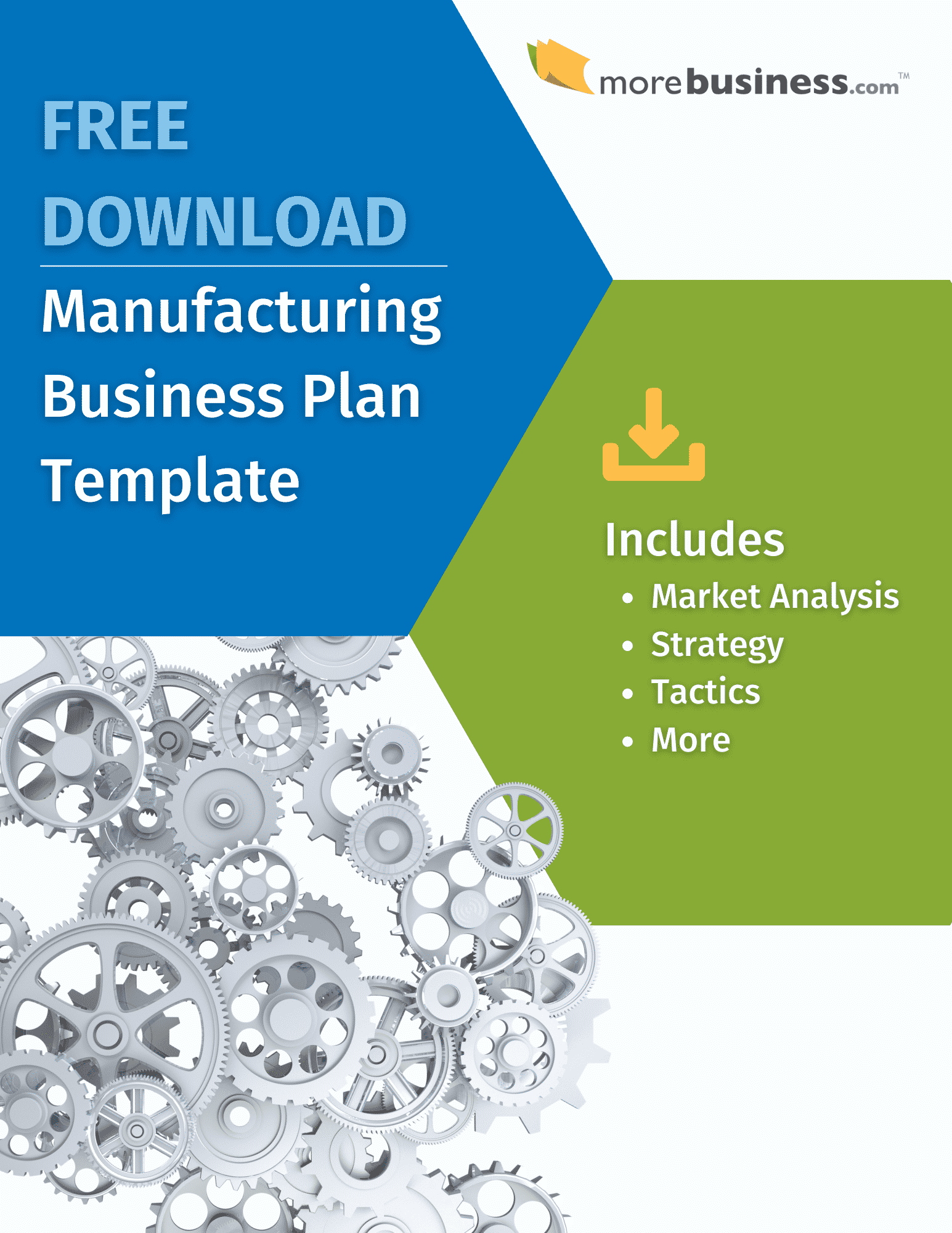
Use this manufacturing business plan as your template to start and grow your manufacturing company. This business plan for a manufacturing company includes market analysis, strategy, and more.
Download this Manufacturing Business Plan free for easy editing in Microsoft Word, Google Docs or Apple Pages to make a PDF:
Also Read: MoreBusiness.com’s Free Starting a Business Guide
Table of Contents
Manufacturing Business Plan
1.0 executive summary, 1.1 company.
Titus Mold Manufacturing, Inc. designs prototypes and molds, which are used by production manufacturers to fabricate consumer products. We are a start-up company that developed and patented revolutionary design software called Virtual Design Center. Our initial plan is to create a precision manufacturing facility to produce prototypes and molds for clients. Our goal is to provide our customers with fast turnaround, exceptional quality, unparalleled customer service, and competitive pricing.
1.2 PRODUCTS & SERVICES
We design and manufacture prototypes and molds. By utilizing Virtual Design Center, we will work in real-time with our customers to meet their design needs, which will reduce errors and detect design flaws early in the process. In turn, this will save the customer time and money. We plan to position ourselves as a forward-thinking company that continually invests in new ideas and technologies – unlike our competitors, which are similar mold manufacturing facilities. Because of our unique software, sophisticated technology and efficient processes, we will be in a position to potentially compete on price and quality. As this manufacturing business plan will outline, our unique Virtual Design Center gives us a definitive advantage.
1.3 MARKET ANALYSIS
The U.S. manufacturing industry makes up a substantial portion of the GDP, and the mold-manufacturing sector generates sales of more than $5 billion. Manufacturing drives the U.S. economy more than any other industry. Within that enormous industry, we have identified two strong markets with very high growth potential – automotive parts and medical devices manufacturing. As new car companies respond to shifting consumer demands for more fuel-efficient cars, and as the medical community develops new technologies, the need for new parts, designs and molds grows.
1.4 STRATEGY & IMPLEMENTATION
To achieve our business goals, we will create a high-tech, precision manufacturing facility and will implement highly efficient operations processes. We plan to promote Titus Mold Manufacturing and our proprietary Virtual Design Software with an aggressive, targeted marketing campaign. This will include a media campaign, print and online advertising and a targeted direct-mail campaign. In addition, we will focus heavily on establishing our presence within the industry at relevant trade shows.
1.5 MANAGEMENT
Our leadership team currently consists of Chief Executive Officer John Baker, President Michael Smith, and Vice President Susan Jones. Additional key leaders will include directors of finance, marketing and sales, human resources, information technology and operations. While these positions remain unfilled at this time, we do have several extremely qualified candidates interested in joining with us in this new venture.
1.6 FINANCIAL PLAN
Our Company will earn revenue from the sale of design services and manufactured molds. The attached Income Statement demonstrates that our gross profit margin will exceed 72%, and we will achieve break-even with sales of $XXX,XXX. We expect to reach profitability by the middle of Year 2.
1.7 SOURCES & USE OF FUNDS
Titus Mold Manufacturing, Inc. requires $4,450,000 to launch. At present, we have raised $150,000 in venture capital funds. In addition, co-owners John Baker, Michael Smith and Susan Jones have each invested $100,000 into the company. We are currently seeking funds from outside investors and business loans.
The start-up funds will be used to cover the facility, build-out costs, equipment, software and initial operating costs including payroll, taxes, and utilities.
2.0 COMPANY
2.1 company & industry.
Titus Mold Manufacturing, Inc. is located in Molder, Missouri. Our company designs and manufactures prototypes and molds for use in casting metals or forming other materials, such as plastics, glass or rubber. Our business operates within the manufacturing industry and is classified under NAICS code 333511 – industrial mold manufacturing.
2.2 LEGAL ENTITY & OWNERSHIP
Titus Mold Manufacturing is an S-Corporation that was formally organized in Missouri. The company’s principal owners are John Baker, Michael Smith and Susan Jones, who hold equal shares of ownership in the company.
2.3 COMPANY HISTORY TO DATE
Our company is a new business that will create prototypes and quality molds, utilizing the latest design software, e-commerce technology, high tech machinery and innovative operations processes. As the company’s founders and owners, we have a combined 40 years of experience in software development and the manufacturing industry. Our experience includes product research and development, engineering and production management. After recognizing the need for and value of creating a more efficient customer experience to secure and retain business, we decided to create Titus Mold Manufacturing, Inc.
2.4 FACILITIES
Our company is preparing to lease a manufacturing facility in Molder, Missouri. We are presently operating out of temporary administrative offices at the Barton Business Incubation Center.
We are working with a local realtor and BBIC to identify potential industrial space available for lease. We require a 10-12,000 sq. ft. facility to accommodate product development and engineering, a mold shop, a tool shop, quality assurance area, inventory storage and administrative offices. As the business grows, we intend to add injection-molding capabilities.
2.5 KEY ASSETS
Titus Mold Manufacturing holds a patent for its revolutionary Virtual Design Center (VDC). The VDC combines the best of virtual and in-person presentations and meetings, allowing customers to work in real-time with our design engineers. This allows us to serve clients nationwide.
3.0 PRODUCTS/SERVICES
3.1 description.
Titus Mold Manufacturing, Inc. will make prototypes and molds for the manufacturing of consumer products. A mold, which is usually made from aluminum or steel, is a hollow form that gives a particular shape to a product while it is in a liquid state. The molds are used for products made from plastic, glass, metal or other raw materials.
There are three main phases to manufacturing a prototype or mold. First, engineers and product developers create a design. Titus Mold Manufacturing is able to complete a design from start to finish for a customer. If need be, Titus will work with the customer through the design process via our one of a kind Virtual Design Center. Secondly, we make test molds. We then inspect and test the molds for quality assurance. Finally, we manufacture prototypes and molds based on specific design specifications, using precision machinery to form the desired prototype or mold.
3.2 FEATURES & BENEFITS
Virtual Design Center will be the key to distinguishing and drawing attention to our company. Once we have a particular industry or customer’s attention, we will sell them on our fast turnaround, exceptional quality, unparalleled customer service and competitive pricing.
Obviously, speed, quality, service and price are qualities most of our competitors will list in their mission statement. However, Titus Mold Manufacturing will – from the beginning – invest in top quality, highly sophisticated machinery as well as implement innovative operations policies. These steps will ensure our ability to deliver beyond normal industry standard and surpass our customers’ expectations saving them time and money.
3.3 COMPETITION
Our competitors are companies that provide similar types of design and mold-making services. There are far too many competitors to list specifically in this manufacturing business plan. To their advantage, they have an established customer base. Further, many mold-making companies also have injection-molding machinery, which enables them to manufacture actual products.
However, the vast majority of our competitors are not taking full advantage of current technology, nor are they implementing modern operational systems. Their waste is ultimately passed along to the customer via longer turnaround times and higher overhead costs .
3.4 COMPETITIVE ADVANTAGE/BARRIERS TO ENTRY
By relying on our technology and an activity-based costing system, rather than a time-based system, we will be able to maintain competitive prices and sustain high profitability. Our technology and systematic efficiencies will allow us to have advantages in cost, speed and design capability. Ultimately, these advantages will quickly come to define Titus Mold Manufacturing as an industry leader.
Our Virtual Design Center technology gives us a significant advantage over our competitors, and our patent prevents others from being able to replicate the services we offer.
3.5 DEVELOPMENT
As our company grows, we plan to expand our facility and create an injection-mold manufacturing plant. At that point, we will be able to control all operations in-house from initial design to mold creation and even mass production of the finished products. In addition, we will stay atop technology trends and upgrade equipment and processes as needed and can be afforded. We will also continue to research and pursue shares of existing markets such as packing, defense, electronics and telecommunications and update portions of this manufacturing business plan accordingly.
4.0 MARKET ANALYSIS
4.1 market size.
The US manufacturing sector includes more than 300,000 companies with combined annual sales of about $4 trillion. Furthermore there are approximately 2,500 mold manufacturers with combined annual sales of more than $5 billion. To capture a portion of those sales, Titus Mold Manufacturing will utilize a targeted industry approach to pursue specific, definable, market segments.
4.2 TARGET CUSTOMER
After extensive research, we decided to initially pursue market segments in the automotive and medical devices industries. These are two very distinct markets with very different needs. While the automotive industry’s purchasing decisions are driven primarily by price, the medical device industry focuses on a fast turnaround time and quality to make purchasing decisions.
The U.S. automobile manufacturing industry includes about 160 companies with combined annual revenue of about $250 billion. While the majority of those sales are swallowed up by a handful of major car manufacturers, there are thousands upon thousands of parts needing to be manufactured for each vehicle. By specializing in manufacturing molds for certain parts, we will establish our niche in the market. Our research indicates this is a perfect time to assimilate into this industry as carmakers make dramatic shifts in design and efficiency to address rising fuel costs.
The medical devices industry is by far one of the most forward-thinking, always-evolving industries. Researchers and product developers are continually striving to improve products and procedures. With this constant change and product evolution comes the constant need for new product molds. Couple the advances in medical technology with an increasingly aging population, and it’s clear the healthcare industry as a whole is a solid market and mold manufacturers will reap the benefits.
4.4 SWOT ANALYSIS
The SWOT analysis for this manufacturing business plan is as follows:
- Propriety software (Virtual Design Center)
- Potential for global customer base
- Manufacturing & production expertise
- Software development expertise
- Understanding of emerging technologies
- Understanding of target markets
- Competitive product pricing
- Exceptional quality and customer service
- Implementation of cost saving processes
- No company history
- Small initial customer base
- Lack of leverage with new relationships
Opportunities
- New products & processes
- Bringing new technology into the industry
- Developing a new reputation
- Hiring new talent
- New innovations and applications of our technology
- Impact of new legislation
- Technologies developed by competitors
- Challenges in building a talented staff
- Retaining key staff members
- Market demand fluctuations
5.0 STRATEGY & IMPLEMENTATION
5.1 philosophy.
Titus Mold Manufacturing’s business philosophy is to make the needs of our customers our main priority. It is our mission to provide our customers with fast turnaround, exceptional quality, unparalleled customer satisfaction and competitive pricing. With the introduction of our patented Virtual Design Center program and the unveiling of our modern design and manufacturing facility, we will position Titus Mold Manufacturing as a superbly innovative company and a future industry leader.
To achieve this position, we will implement our company’s plan to create a state-of-the-art mold-manufacturing facility and invest in the most accurate precision machinery available. We will implement the most comprehensive design software and set the highest standards of operational systems and quality control.
5.2 INTERNET STRATEGY
Our plan is to position Titus Mold Manufacturing as a technology-driven innovative company within the mold-manufacturing sector of the manufacturing industry. To do this, we are putting forth a great amount of time and resources into developing a premiere Web site. We are working with a design firm and have secured a domain name – TitusMolds.com. We have already initiated the process of integrating our Virtual Design Center into the site.
In addition to describing our manufacturing processes and design capabilities, we will feature numerous success stories and images of prototypes and molds we have produced. Our site will also include a simple online form to complete for custom quotes as well as a generic form to submit questions and comments.
Our vision is to create a Web site that will become an integral part of our marketing, sales and daily operations. We will use Wix to set up our site. This tool has all of the features we need, including the ability to create and edit the site very quickly. It also has ecommerce and other capabilities. Using Wix will also enable us to save money since we can create the site ourselves and will not have to hire a web designer.
5.3 MARKETING STRATEGY

In addition to conveying to our potential customers the fast turnaround, exceptional quality, unparalleled customer service and competitive pricing offered by Titus Mold Manufacturing, we will also position our company as future-minded and a leader in the integration of innovative technology into the mold manufacturing process.
Our marketing plan will include an initial publicity campaign that introduces our company and patented Virtual Design Center. Further, we will launch a comprehensive advertising campaign in automotive manufacturing and medical devise trade publications and related Web sites. The publicity campaign will be closely followed by a direct-mail campaign to targeted customers.
The other main component of our marketing plan will be to attend trade shows which will require booth construction and maintenance, marketing materials such as brochures, and promotional items such as pens with our logo.
To increase local awareness of our company and to foster a positive public perception, we will participate in and sponsor local charity events such as Walk for the Cure and March of Dimes and youth sports teams. We will also reach out to local high schools and colleges to offer internships and promote careers in manufacturing.
5.4 SALES STRATEGY
Titus Mold Manufacturing will build a sales team focused on securing new business in the short and long term. The sales team will be motivated by commissions and performance-based bonuses.
Under the direction of executive management, we will employ an outside sales staff as well as an inside sales staff, which will be cross-trained to handle general customer service calls. The outside sales staff will focus primarily on trade show attendance, comprehensive follow up, relationship building, closing deals, and securing referrals.
5.5 STRATEGIC ALLIANCES
We plan to develop strategic alliances with local and regional injection-molding manufacturing facilities that do not have mold-making capabilities within their facilities. One such alliance has been developed with Hilden Manufacturing Company located within our region. More are developing.
5.6 OPERATIONS
Our facility’s space will be divided in proportion to our needs and will include product development and engineering labs, mold shop, tool shop, quality control and testing area, inventory storage and administrative offices. Each area will be staffed with trained employees and wherever possible factory-floor technicians will be cross-trained. Our administrative offices will include space for executive, marketing and sales, accounting, information technology, security, maintenance, and human resource departments. To become a fully operational mold-manufacturing facility, we will require the following machinery and software.
- Viper, SLA 7000 & SLA 5000
- Eden260, Eden333 & Eden500V
- Vantage, Titan & Maxum
- RTV Tooling
By utilizing the latest precision machinery and software and superior operational and quality control processes such as LEAN Manufacturing, Rapid Prototyping and Manufacturing, and Six Sigma , Titus Mold Manufacturing will control costs while ensuring quality. Additionally, once we are operational, our company will become ISO 9001-2000 certified. Titus will also follow FDA requirements and comply with Medical Directive standards to further ensure quality control.
Operationally, our strengths lie in our knowledge and expertise within the manufacturing industry. We know what fixed assets we require and what regulations we must adhere to. However, while we cannot know for certain the quality of our managerial team at this point, we expect to hire and implement a top notch team. As previously mentioned, we have several promising prospects and will, of course, strive to recruit top talent.
The following is a list of business goals and milestones we wish to accomplish within the next three years.
- Secure necessary funds.
- Locate and lease suitable manufacturing facility.
- Purchase machinery, equipment and supplies.
- Hire skilled employees to complete our team.
- Set up shop and open for business.
- Successfully penetrate targeted markets.
- Secure contracts to achieve projected sales goals.
- Become a profitable company.
- Establish a solid reputation as an industry leader.
Our first major milestones will be securing funds and setting up our business. This is our primary focus right now. In three years, we hope to have established our company in the community and within our industry.
5.8 EXIT STRATEGY
Should management or our investors seek a business exit, there are several options we would be willing to pursue. Our company could most likely be sold to a manufacturing company that does not already have mold manufacturing capabilities. A management buyout could also be pursued once our business credit is firmly established.
6.0 MANAGEMENT ORGANIZATIONAL STRUCTURE
6.1 organizational structure.
Titus Mold Manufacturing understands the importance of a loyal and enthusiastic team to reduce turnover and increase productivity. Our company’s management philosophy will encourage responsibility and mutual respect. While we will present a strong decisive management team, we will also foster an atmosphere of genuine employee appreciation and open communication.
6.2 LEADERSHIP
Our company will be managed and run by our executive staff including Chief Executive Officer John Baker, President Michael Smith, and Vice President Susan Jones, as well as our Board of Directors. Our management staff of directors and supervisors will oversee daily operations. However, as a small manufacturing facility starting out, the CEO, President and VP will be responsible for the majority of purchasing, hiring, training, quality control, and additional day-to-day duties.
Additional key leaders will include directors of finance, marketing and sales, human resources, information technology and operations. While these positions remain unfilled at this time, we do have several extremely qualified candidates interested in joining with us in this new venture.
As we start our mold manufacturing business, we will implement a plan to hire management and production staff first and fill in with mid-level management and administrative staff as our budget and needs change.
6.3 BOARD MEMBERS & ADVISORS
Our Board of Directors is not yet fully formed. CEO John Baker will serve as Chairman. The board will consist of company owners (shareholders), officers and directors.
Duties of the Board of Directors may include:
- Establishing broad company policies and objectives.
- Selecting, appointing, and reviewing the performance of executive staff.
- Insuring the availability of adequate financial resources and approving annual budgets.
- Accounting to the stakeholders for the organization’s performance
We will actively seek individuals to sit on our Board of Directors who will have the ability to add to and advise our organization such as lawyers, accountants, and professionals in the automotive or medical fields.
7.0 FINANCIAL PLAN
7.1 requirements.
Titus Mold Manufacturing, Inc. requires $4,450,000 to launch and operate. We are currently seeking funding from outside investors and business loans. We are also looking into additional options including supplier financing, deferred rent, subleasing space, partnerships, vending and client advance payment.
At this time, we have raised $450,000 in working capital and are seeking the additional funds to start our business. We have raised $150,000 in venture capital funds. In addition, co-owners John Baker, Michael Smith and Susan Jones have each invested $100,000 into the company.
7.2 USE OF FUNDS
The start-up funds will be used to cover operating costs including payroll, taxes, and utilities. Start-up funds will also be used to purchase capital expenditures such as leasehold improvements, software and machinery, which will produce future benefits for the company. Approximately forty percent will be spent on assets, while the other sixty percent will be spent on operations until we realize profitability.
7.3 INCOME STATEMENT PROJECTIONS
The accompanying income statement demonstrates our company’s profitability. Our income shows a gross profit margin of seventy-two percent. Our monthly operating expenses average $116,325. Projected net income will average $54,075 per month in our third year.
After completing a comprehensive break-even analysis, we will achieve our break-even point by the middle of year two.
7.4 CASH FLOW PROJECTIONS
The nature of our business requires that our company collect payment after the product is complete. So we have included the accompanying cash flow statement, which projects our monthly flow of cash. While we expect to reach break-even by our eighteenth month, it will take nearly two years to become cash flow positive.
7.5 BALANCE SHEET
Our balance sheet will depend greatly on our sources of capital. We expect to raise approximately $1.5 million through loans and $2.95 million through equity capital.
Our assets will be comprised of cash, leasehold improvements, equipment, software and other tangible assets.
7.6 ASSUMPTIONS
Our projections are based on the assumption that the manufacturing industry, particularly the medical and automotive industries, will continue to follow present trends. Industry regulation and government legislation is always poised to interfere with business projections, but there are no indications at this time to expect any negative influence to our projections. Additionally, we are not relying on new regulations or the passage of new legislation to enable our company to reach our projected numbers.
Get This Manufacturing Business Plan Example
Download this Manufacturing Business Plan free for easy editing in Microsoft Word, Google Docs or Apple Pages:
While you’re here, need a sample marketing plan? Download ours free:
- Marketing Plan Example
Like this? Share it with your network:
I need help with:, popular topics:.
- Learning SEO
- Generating Sales
- Writing a Marketing Plan
- Writing a Business Plan
- Leading My Team
- Free Marketing Webinars
- Starting My First Business
Got a Question?
Get personalized expert answers to your business questions – free.
Affiliate Disclosure : This post may contain affiliate links, meaning we get a commission if you decide to purchase something using one of our links at no extra cost to you.
You Might Also Like...

SEO Title Tag Makeover: 4 Powerful Examples

5 Steps to Design an Effective Employee Engagement Action Plan

4 Actionable Steps to Find a Mentor for Your Business

5 Effective Scheduling Tips To Boost Your Productivity

Business Coaching vs Executive Coaching: 10 Examples

7 Employee Satisfaction Secrets: Nurturing a Happy Small Business Team

Secure Your First 10 Investors: Step-by-Step Startup Guide

B2B SaaS SEO: Best Practices Guide

SEO Coaching and Marketing Courses
Get More Business
Marketing tools.
- SEO Keyword Tool
- MSP Website Content Kit
- Done-for-You Content
- Graphic Design Tool
- Webinar Automation
- Getting Referrals
- Hubspot Marketing Automation
Popular Downloads
- MSP Marketing Plan
- Life Coach Business Plan
- Consulting Business Plan
- How to Write a Business Plan
- Clothing Line Business Plan
- Restaurant Business Plan
- Personal Trainer Business Plan
- Trucking Business Plan
- Pizza Restaurant Business Plan
Free Guides
- B2B SaaS SEO Best Practices
- MSP SEO Marketing Playbook
- Buyer Persona Examples
- How to Increase Google Rankings
- New Client Welcome Package
- How to Create a Happy Customer
- Brand Development Guide
- SaaS Metrics Dashboard
- Marketing and SEO Videos
- Salary Calculator
- Executive Coaching Newsletter
- Contributing Content
- Affiliate Disclosure
Manufacturing Business Plan Template
Written by Dave Lavinsky
Manufacturing Business Plan
You’ve come to the right place to create your Manufacturing business plan.
We have helped over 1,000 entrepreneurs and business owners create business plans and many have used them to start or grow their Manufacturing companies.
Below is a template to help you create each section of your Manufacturing business plan.
Executive Summary
Business overview.
Perfect Snacks, located in Lincoln, Nebraska, is a food manufacturing company that specializes in the production of snack foods and packaged goods. We manufacture an extensive line of snack products, including trail mix, gummies, and chocolate. Our company focuses on quality and only uses the best natural ingredients in our products. We will primarily sell our products to grocery stores and other establishments that sell snacks, but will also sell bulk orders to individual customers through our website.
Perfect Snacks was founded by Joe Boseley. Joe has been working on the manufacturing company concept over the past few years and began networking with grocery store clients and locating the land to build his manufacturing and distribution center. As a line manager that oversaw dozens of employees, Joe has the proper knowledge and experience to own, manage, and operate his own manufacturing company.
Product Offering
Perfect Snacks will manufacture an extensive list of sweet, salty, and healthy snacks. Some of our initial products will include:
We will primarily sell our products to grocery stores, recreation centers, and other businesses that sell snacks in bulk. Consumers can find our products in stores or buy them in bulk on our website.
Customer Focus
Perfect Snacks will primarily serve the residents of Lincoln, Nebraska. The community has a large population of families and children, who are the primary consumers of snack foods. Therefore, we will market our products to recreational centers, schools, grocery stores, and other establishments that sell snacks to children and their parents.
Management Team
Perfect Snacks is owned by Joe Boseley, a local entrepreneur who has worked in various warehouses and manufacturing companies in Lincoln, Nebraska. Working in the manufacturing industry and in warehouses, Joe is very familiar with the processing and distribution of packaged foods. As a line manager that oversaw dozens of employees, Joe has the proper knowledge and experience to own, manage, and operate his own manufacturing company.
Joe will utilize his past experience with developing staff roles and functions. He is also very familiar with the manufacturing equipment and plans to purchase the latest technology that is efficient and cost effective. His contacts have allowed him to gain concrete Letters of Intent from local supermarket chains to have his manufactured goods in their stores.
Success Factors
Perfect Snacks will be able to achieve success by offering the following competitive advantages:
- Taste: Perfect Snacks’ snack products will be made with the highest quality ingredients and offer quality over quantity.
- Price: Perfect Snacks is able to offer the highest quality snacks at a competitive price point.
- Community Relations: Perfect Snacks will be a pillar in the community and be heavily involved in family-related activities in the area. It will sponsor events, provide snacks for schools and daycares at a discounted price, and donate a portion of its proceeds to area family-related charities and organizations.
- Proprietary Technology: Perfect Snacks will invest heavily on the latest technology to manufacture the snack foods for distribution. It will ensure the food products are made safely and free from any harmful chemicals and ingredients.
Financial Highlights
Perfect Snacks is seeking a total funding of $1,200,000 of debt capital to open its manufacturing company. The capital will be used for funding capital expenditures, salaries, marketing expenses, and working capital. Specifically, these funds will be used as follows:
- Manufacturing facility design/build-out: $400,000
- Equipment and supplies: $375,000
- Initial inventory: $100,000
- Three months of overhead expenses (payroll, rent, utilities): $250,000
- Marketing costs: $50,000
- Working capital: $25,000
The following graph below outlines the pro forma financial projections for Perfect Snacks.
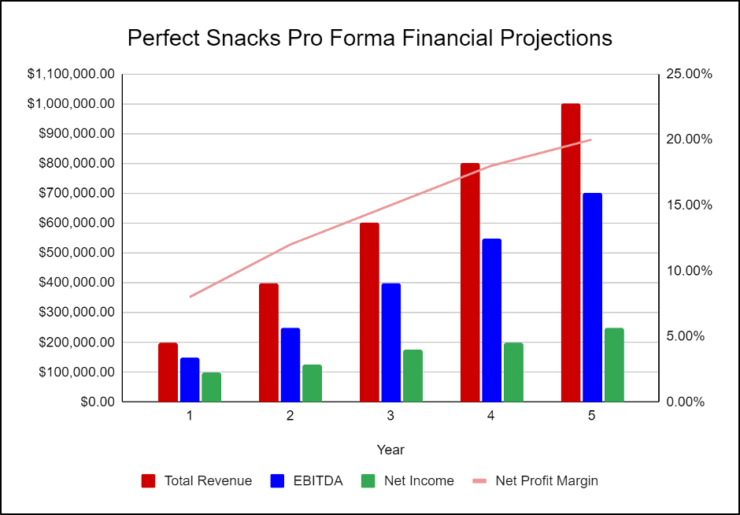
Company Overview
Who is perfect snacks, perfect snacks history.
After conducting a market analysis, Joe Boseley began surveying the local vacant warehouse space and decided on a parcel of land to construct the warehouse and distribution center. Joe incorporated Perfect Snacks as a Limited Liability Corporation on January 1st, 2023.
Once the land is acquired for the warehouse space, construction can begin to build-out the manufacturing facility.
Since incorporation, the Company has achieved the following milestones:
- Located a vacant lot that would be ideal for a manufacturing facility
- Developed the company’s name, logo, and website
- Hired a general contractor and architect for the build-out of the warehouse, small office, and distribution area
- Determined equipment and necessary supplies
- Determined beginning inventory
- Attained Letters of Intent from supermarket clients
- Began recruiting key employees
Perfect Snacks Services
Industry analysis.
The Manufacturing sector’s performance is largely attributable to the value of the US dollar, commodity prices, policy decisions and US manufacturing capacity. Food manufacturing has a history of success as it produces a basic human need. According to Grand View Research, the industry is currently valued at $121 billion and is expected to expand at a compound annual growth rate of 9.5% from now until 2030.
Commodity prices are currently stabilizing from coronavirus-induced volatility and renewed demand, both in the United States and global economies, which is anticipated to facilitate revenue expansion for manufacturers. Moreover, shifting technological change in the Manufacturing sector is anticipated to benefit large, developed economies, such as the United States. Therefore, now is a great time to start a new food manufacturing company in the U.S.
Customer Analysis
Demographic profile of target market.
Perfect Snacks will serve the community residents of Lincoln, Nebraska and its surrounding areas. The community of Lincoln, Nebraska has thousands of households that have children. Statistics show that the main consumers of snack products are children of all ages. They are regularly placed in school lunchboxes, afterschool snacks and programs, and at weekend sporting events. Therefore, we will market to locations where snacks are bought by children or their parents, such as grocery stores, recreational centers, and schools.
The precise demographics Lincoln, Nebraska is as follows:
| Total | Percent | |
|---|---|---|
| Total population | 1,680,988 | 100% |
| Male | 838,675 | 49.9% |
| Female | 842,313 | 50.1% |
| 20 to 24 years | 114,872 | 6.8% |
| 25 to 34 years | 273,588 | 16.3% |
| 35 to 44 years | 235,946 | 14.0% |
| 45 to 54 years | 210,256 | 12.5% |
| 55 to 59 years | 105,057 | 6.2% |
| 60 to 64 years | 87,484 | 5.2% |
| 65 to 74 years | 116,878 | 7.0% |
| 75 to 84 years | 52,524 | 3.1% |
Customer Segmentation
Perfect Snacks will primarily target the following customer profiles:
- Grocery stores and recreational centers
Competitive Analysis
Direct and indirect competitors.
Perfect Snacks will face competition from other companies with similar business profiles. A description of each competitor company is below.
Snacks N More
Snacks N More is another local manufacturing company that provides snack food to the immediate area. Established over thirty years ago, the company has the knowledge and expertise in food processing, commercialization, and packaging. They are known as a recognized ingredient supplier for the foodservice industry. Their portfolio of products include a variety of nuts, snacks, confections, and dry-blend ingredients. As a private label manufacturer, Snack’s More produces a full line of non-chocolate candy, nuts, and fruit-flavored snacks. The company is known for their fruit flavored snacks, dried raisins, nut mixes, and producing ingredients for local restaurants and establishments. Their line of nuts and dried fruits are often used for baking purposes.
Jaxon’s Candy
Jaxon’s Candy is a manufacturer of all things candy related. As a contract manufacturer, the company works with many companies to create their custom designed confections. Their large 50,000 square foot facility produces over 300,000 pounds of candy every month. All of the products are highly concentrated either in sugar or chocolate, or both. Jaxon’s Candy also designs and manufactures their own custom packaging. The candy produced is also kosher certified, gluten free, peanut free, and non-GMO.
Jaxon’s Candy currently manufactures candy for the following brands – Tommy Candy, Laffy Town, Chocowhoawhoa, Jellylicious, Healthee Candeee, and Sticky Teeth. Jaxon’s Candy can be found in grocery stores and convenient stores along the west coast of the United States.
Gimmy Candy
Gimmy Candy is located in the midwestern portion of the United States and boasts a facility of over 1 million square feet. Their fleet of transportation trucks distributes throughout the continental United States and is considered one of the largest candy manufacturers in the country. Their product portfolio includes assorted chocolates, gummy candy, hard candy, fruit candy, as well as gums and mints. Gimmy Candy was established in 1947 and has grown to be a model of manufacturing companies the industry uses as a model of sustainability and profitability. Their lineup of candy products can be found in every single grocery store and convenient store in the country. Gimmy Candy is considering expanding its distribution globally and start exporting its candy products to Asia, Canada, Europe, and South America. As one of the largest privately held companies in the United States, Gimmy Candy is also considered a top employer in the country and offers its employees a generous benefits package.
Competitive Advantage
Perfect Snacks will be able to offer the following advantages over their competition:
Marketing Plan
Brand & value proposition.
Perfect Snacks will offer the unique value proposition to its clientele:
- Fresh and comforting taste
- Community family advocate
- Developed with proprietary technology
- Manufactured with fresh, quality ingredients
- Affordable price
Promotions Strategy
The promotions strategy for Perfect Snacks is as follows:
Social Media
Perfect Snacks will invest heavily in a social media advertising campaign. The brand manager will create the company’s social media accounts and invest in ads on all social media accounts. It will use targeted marketing to appeal to the target demographics.
Website/SEO
Perfect Snacks will invest heavily in developing a professional website that displays all of the features and benefits of the snack products. It will also invest heavily in SEO so that the brand’s website will appear at the top of search engine results.
Major Publications
We will also invest in advertising in selected larger publications until we have achieved significant brand awareness. Advertisements such as billboards and commercials will be shown during peak tv watching time and the billboards will be placed in highly trafficked areas.
Sponsorships
Perfect Snacks will also invest in sponsoring certain athletic and school events so that their banners and collateral material are displayed all over the event where numerous parents and children are at.
Perfect Snacks’s pricing will be moderate so consumers feel they receive great value when purchasing our snack products.
Operations Plan
The following will be the operations plan for Perfect Snacks.
Operation Functions:
- Joe Boseley will be the CEO of Perfect Snacks. He will oversee the general operations and executive aspects of the business.
- Joe is joined by Candace Smith who will act as the warehouse manager. She will train and manage the staff as well as oversee general production of our products.
- Joe will hire an Administrative Assistant, Marketing Manager, and Accountant, to handle the administrative, marketing, and bookkeeping functions of the company.
- Joe will also hire several employees to manufacture our products and maintain the equipment and machinery.
Milestones:
Perfect Snacks will have the following milestones complete in the next six months.
- 02/202X Finalize lease agreement
- 03/202X Design and build out Perfect Snacks
- 04/202X Hire and train initial staff
- 05/202X Kickoff of promotional campaign
- 06/202X Launch Perfect Snacks
- 07/202X Reach break-even
Financial Plan
Key revenue & costs.
Perfect Snacks’s revenues will come primarily from its snack food sales. The company will sell the packaged snacks in local grocery stores, convenience stores, and other locations. As the company’s revenues increase, it will look to gain a wider distribution area.
The land purchase, equipment, supplies, opening inventory, and labor expenses will be the key cost drivers of Perfect Snacks. Other cost drivers include taxes, business insurance, and marketing expenditures.
Funding Requirements and Use of Funds
Key assumptions.
The following outlines the key assumptions required in order to achieve the revenue and cost numbers in the financials and pay off the startup business loan.
- Average order value: $250
Financial Projections
Income statement.
| FY 1 | FY 2 | FY 3 | FY 4 | FY 5 | ||
|---|---|---|---|---|---|---|
| Revenues | ||||||
| Total Revenues | $360,000 | $793,728 | $875,006 | $964,606 | $1,063,382 | |
| Expenses & Costs | ||||||
| Cost of goods sold | $64,800 | $142,871 | $157,501 | $173,629 | $191,409 | |
| Lease | $50,000 | $51,250 | $52,531 | $53,845 | $55,191 | |
| Marketing | $10,000 | $8,000 | $8,000 | $8,000 | $8,000 | |
| Salaries | $157,015 | $214,030 | $235,968 | $247,766 | $260,155 | |
| Initial expenditure | $10,000 | $0 | $0 | $0 | $0 | |
| Total Expenses & Costs | $291,815 | $416,151 | $454,000 | $483,240 | $514,754 | |
| EBITDA | $68,185 | $377,577 | $421,005 | $481,366 | $548,628 | |
| Depreciation | $27,160 | $27,160 | $27,160 | $27,160 | $27,160 | |
| EBIT | $41,025 | $350,417 | $393,845 | $454,206 | $521,468 | |
| Interest | $23,462 | $20,529 | $17,596 | $14,664 | $11,731 | |
| PRETAX INCOME | $17,563 | $329,888 | $376,249 | $439,543 | $509,737 | |
| Net Operating Loss | $0 | $0 | $0 | $0 | $0 | |
| Use of Net Operating Loss | $0 | $0 | $0 | $0 | $0 | |
| Taxable Income | $17,563 | $329,888 | $376,249 | $439,543 | $509,737 | |
| Income Tax Expense | $6,147 | $115,461 | $131,687 | $153,840 | $178,408 | |
| NET INCOME | $11,416 | $214,427 | $244,562 | $285,703 | $331,329 |
Balance Sheet
| FY 1 | FY 2 | FY 3 | FY 4 | FY 5 | ||
|---|---|---|---|---|---|---|
| ASSETS | ||||||
| Cash | $154,257 | $348,760 | $573,195 | $838,550 | $1,149,286 | |
| Accounts receivable | $0 | $0 | $0 | $0 | $0 | |
| Inventory | $30,000 | $33,072 | $36,459 | $40,192 | $44,308 | |
| Total Current Assets | $184,257 | $381,832 | $609,654 | $878,742 | $1,193,594 | |
| Fixed assets | $180,950 | $180,950 | $180,950 | $180,950 | $180,950 | |
| Depreciation | $27,160 | $54,320 | $81,480 | $108,640 | $135,800 | |
| Net fixed assets | $153,790 | $126,630 | $99,470 | $72,310 | $45,150 | |
| TOTAL ASSETS | $338,047 | $508,462 | $709,124 | $951,052 | $1,238,744 | |
| LIABILITIES & EQUITY | ||||||
| Debt | $315,831 | $270,713 | $225,594 | $180,475 | $135,356 | |
| Accounts payable | $10,800 | $11,906 | $13,125 | $14,469 | $15,951 | |
| Total Liability | $326,631 | $282,618 | $238,719 | $194,944 | $151,307 | |
| Share Capital | $0 | $0 | $0 | $0 | $0 | |
| Retained earnings | $11,416 | $225,843 | $470,405 | $756,108 | $1,087,437 | |
| Total Equity | $11,416 | $225,843 | $470,405 | $756,108 | $1,087,437 | |
| TOTAL LIABILITIES & EQUITY | $338,047 | $508,462 | $709,124 | $951,052 | $1,238,744 |
Cash Flow Statement
| FY 1 | FY 2 | FY 3 | FY 4 | FY 5 | ||
|---|---|---|---|---|---|---|
| CASH FLOW FROM OPERATIONS | ||||||
| Net Income (Loss) | $11,416 | $214,427 | $244,562 | $285,703 | $331,329 | |
| Change in working capital | ($19,200) | ($1,966) | ($2,167) | ($2,389) | ($2,634) | |
| Depreciation | $27,160 | $27,160 | $27,160 | $27,160 | $27,160 | |
| Net Cash Flow from Operations | $19,376 | $239,621 | $269,554 | $310,473 | $355,855 | |
| CASH FLOW FROM INVESTMENTS | ||||||
| Investment | ($180,950) | $0 | $0 | $0 | $0 | |
| Net Cash Flow from Investments | ($180,950) | $0 | $0 | $0 | $0 | |
| CASH FLOW FROM FINANCING | ||||||
| Cash from equity | $0 | $0 | $0 | $0 | $0 | |
| Cash from debt | $315,831 | ($45,119) | ($45,119) | ($45,119) | ($45,119) | |
| Net Cash Flow from Financing | $315,831 | ($45,119) | ($45,119) | ($45,119) | ($45,119) | |
| Net Cash Flow | $154,257 | $194,502 | $224,436 | $265,355 | $310,736 | |
| Cash at Beginning of Period | $0 | $154,257 | $348,760 | $573,195 | $838,550 | |
| Cash at End of Period | $154,257 | $348,760 | $573,195 | $838,550 | $1,149,286 |
Manufacturing Business Plan FAQs
What is a manufacturing business plan.
A manufacturing business plan is a plan to start and/or grow your manufacturing business. Among other things, it outlines your business concept, identifies your target customers, presents your marketing plan and details your financial projections.
You can easily complete your Manufacturing business plan using our Manufacturing Business Plan Template here .
What are the Main Types of Manufacturing Businesses?
There are a number of different kinds of manufacturing businesses , some examples include: Garment manufacturing, Food product manufacturing, Diaper manufacturing, Tile manufacturing, and Toy manufacturing.
How Do You Get Funding for Your Manufacturing Business Plan?
Manufacturing businesses are often funded through small business loans. Personal savings, credit card financing and angel investors are also popular forms of funding.
What are the Steps To Start a Manufacturing Business?
Starting a manufacturing business can be an exciting endeavor. Having a clear roadmap of the steps to start a business will help you stay focused on your goals and get started faster.
1. Develop A Manufacturing Business Plan - The first step in starting a business is to create a detailed manufacturing business plan that outlines all aspects of the venture. This should include potential market size and target customers, the services or products you will offer, pricing strategies and a detailed financial forecast.
2. Choose Your Legal Structure - It's important to select an appropriate legal entity for your manufacturing business. This could be a limited liability company (LLC), corporation, partnership, or sole proprietorship. Each type has its own benefits and drawbacks so it’s important to do research and choose wisely so that your manufacturing business is in compliance with local laws.
3. Register Your Manufacturing Business - Once you have chosen a legal structure, the next step is to register your manufacturing business with the government or state where you’re operating from. This includes obtaining licenses and permits as required by federal, state, and local laws.
4. Identify Financing Options - It’s likely that you’ll need some capital to start your manufacturing business, so take some time to identify what financing options are available such as bank loans, investor funding, grants, or crowdfunding platforms.
5. Choose a Location - Whether you plan on operating out of a physical location or not, you should always have an idea of where you’ll be based should it become necessary in the future as well as what kind of space would be suitable for your operations.
6. Hire Employees - There are several ways to find qualified employees including job boards like LinkedIn or Indeed as well as hiring agencies if needed – depending on what type of employees you need it might also be more effective to reach out directly through networking events.
7. Acquire Necessary Manufacturing Equipment & Supplies - In order to start your manufacturing business, you'll need to purchase all of the necessary equipment and supplies to run a successful operation.
8. Market & Promote Your Business - Once you have all the necessary pieces in place, it’s time to start promoting and marketing your manufacturing business. This includes creating a website, utilizing social media platforms like Facebook or Twitter, and having an effective Search Engine Optimization (SEO) strategy. You should also consider traditional marketing techniques such as radio or print advertising.
All Formats
Plan Templates
15+ manufacturing business plan templates.
If you’re striking out on your own to start a business, whatever sort it might be, you will benefit from having a business plan template to work from. Such a tool will aid you in your crucial planning and takeoff stages. But there’s more to a business than getting started, and how you proceed from there will largely grow out of the conditions you’ve set for yourself in your business plan. This becomes especially important when you are getting into commodity production. Nowhere else is your command of production lines, personnel, and funding going to be so hard-pressed as in a simple manufacturing business.

Plan Template Bundle
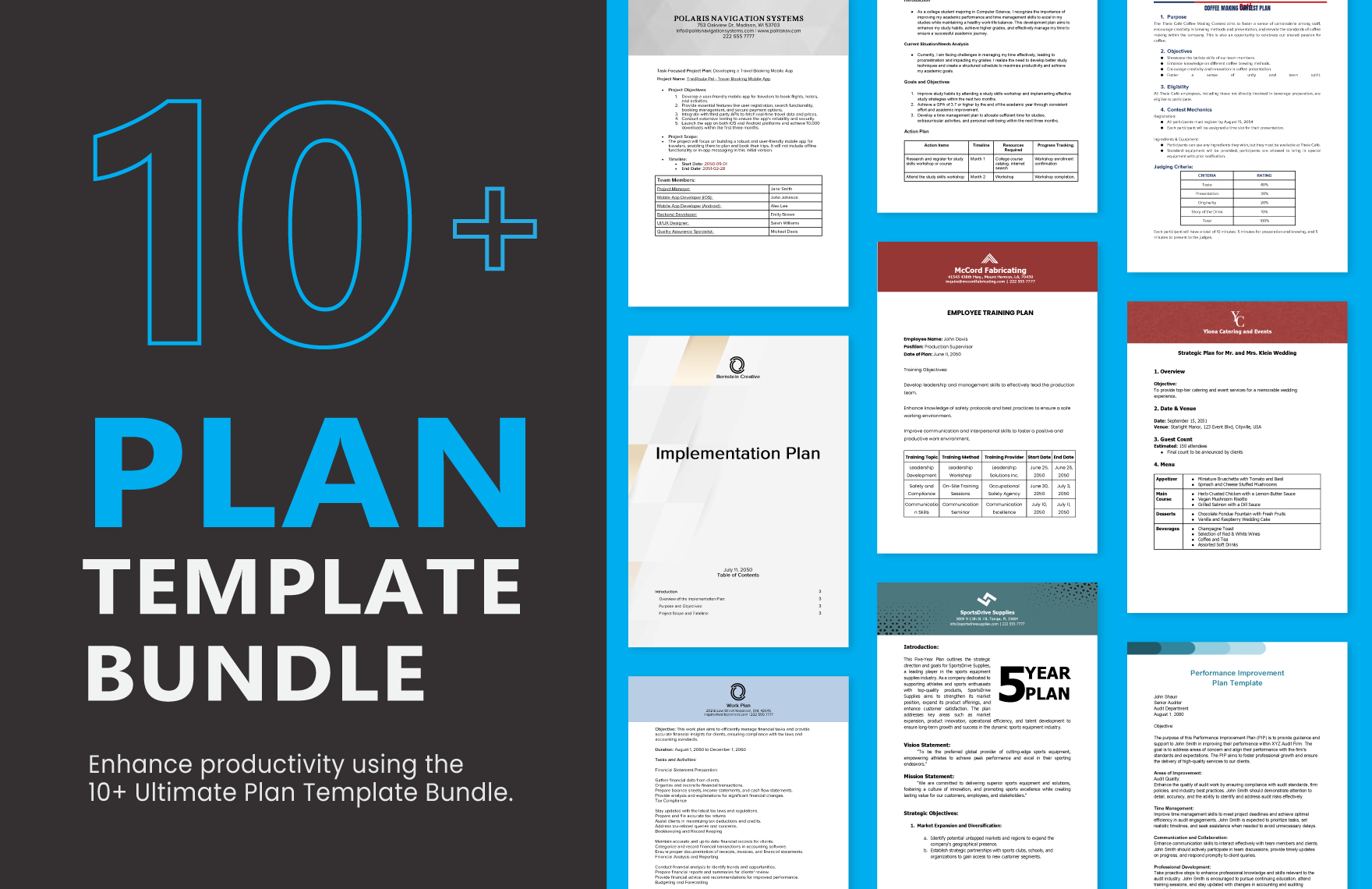
- Google Docs
Construction Business Plan Template Bundle
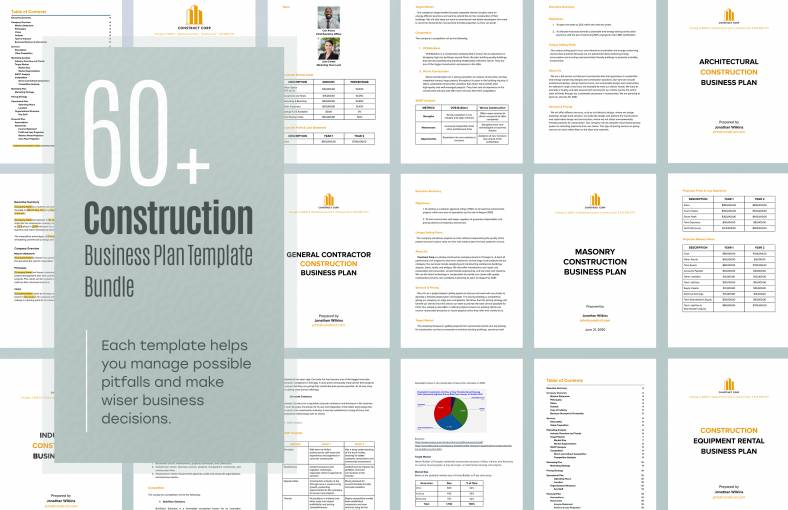
Construction Business Continuity Plan Bundle
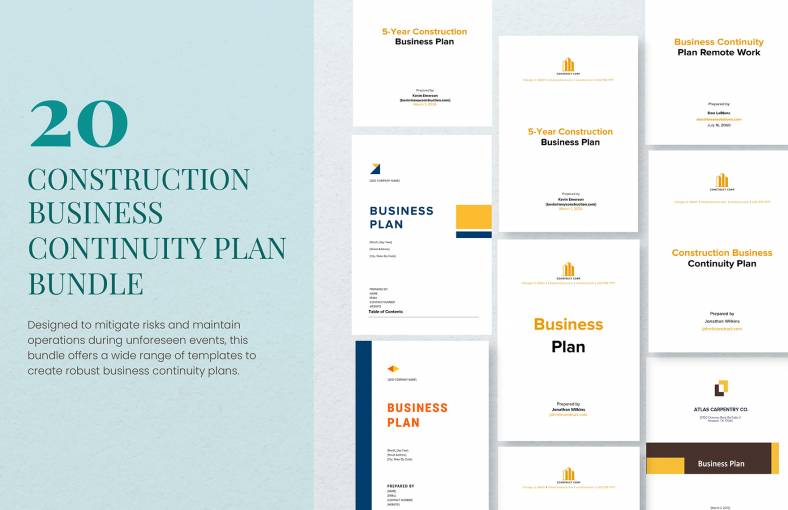
Construction Marketing Business Plan Template Bundle
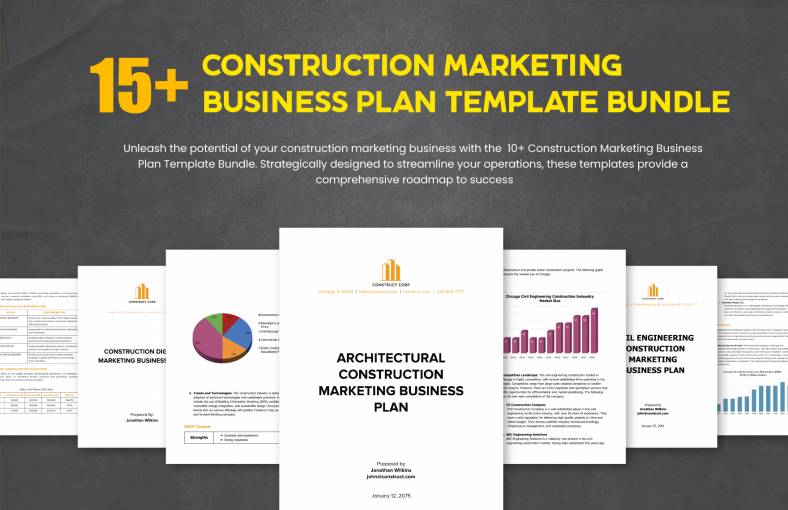
Manufacturing Business Plan Template
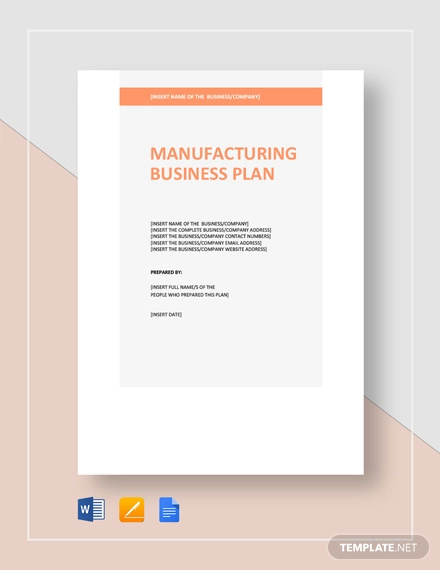
Factory Business Plan Template
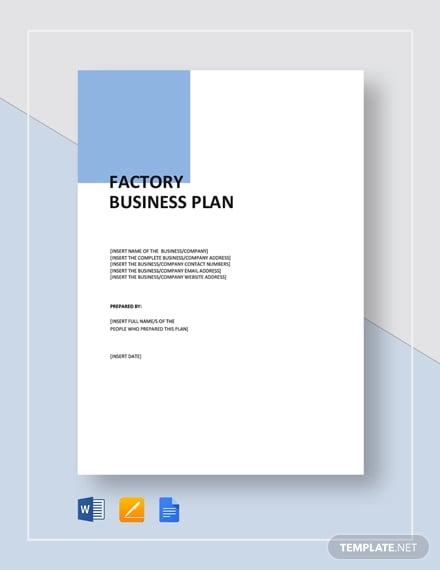
Business Plan Outline in Word
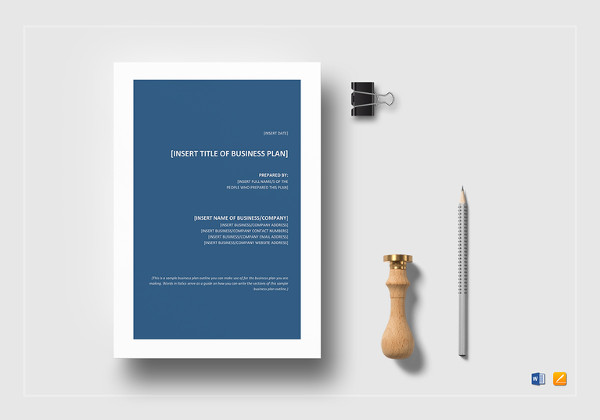
Printable Business Plan Template in Word
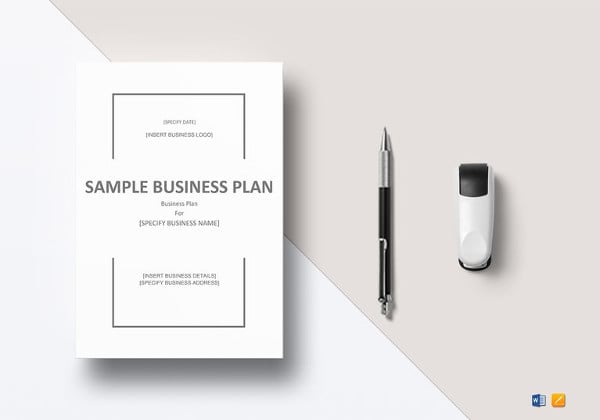
Simple Business Plan Template
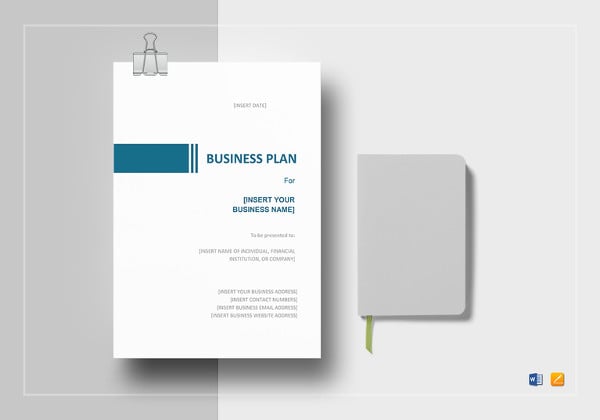
Business Continuity Plan Template
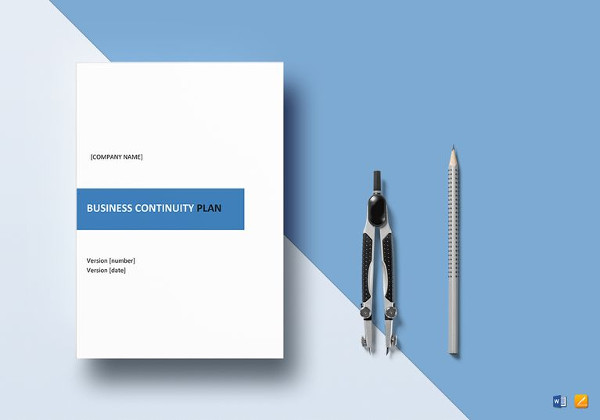
Editable Marketing Business Plan Template

Retail Business Plan Template
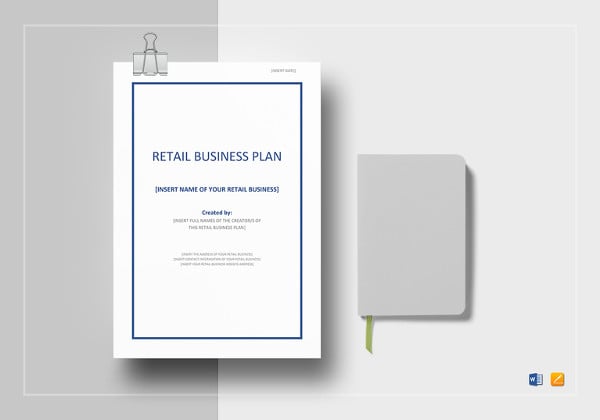
Food Manufacturing Business Plan Template
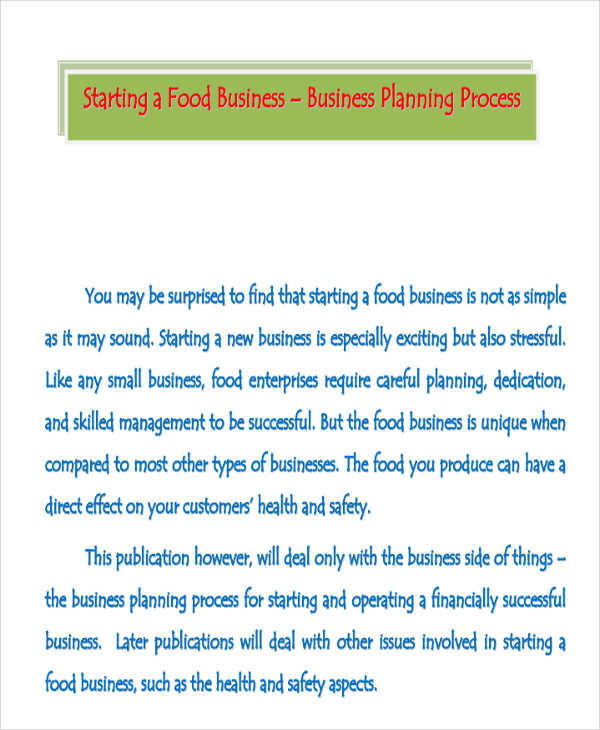
Clothing Manufacturing Business Plan Template
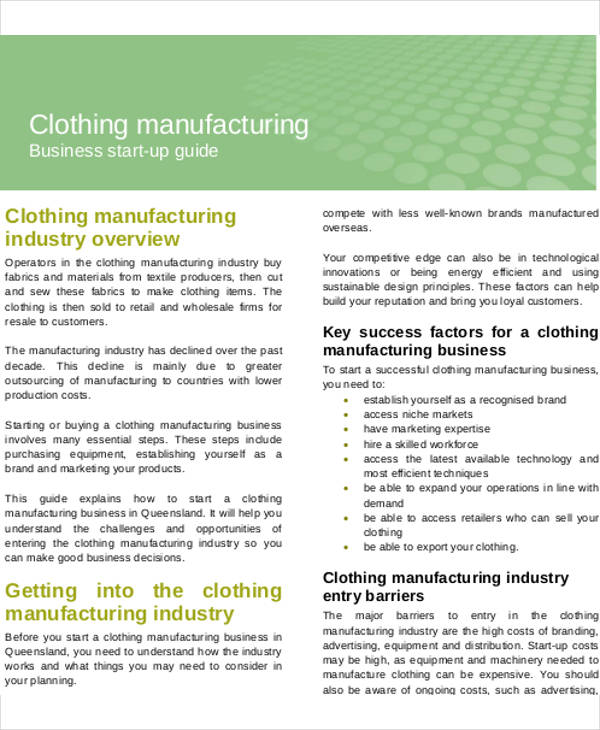
Brick Manufacturing Business Plan Template

Manufacturing Business Continuity Plan Template
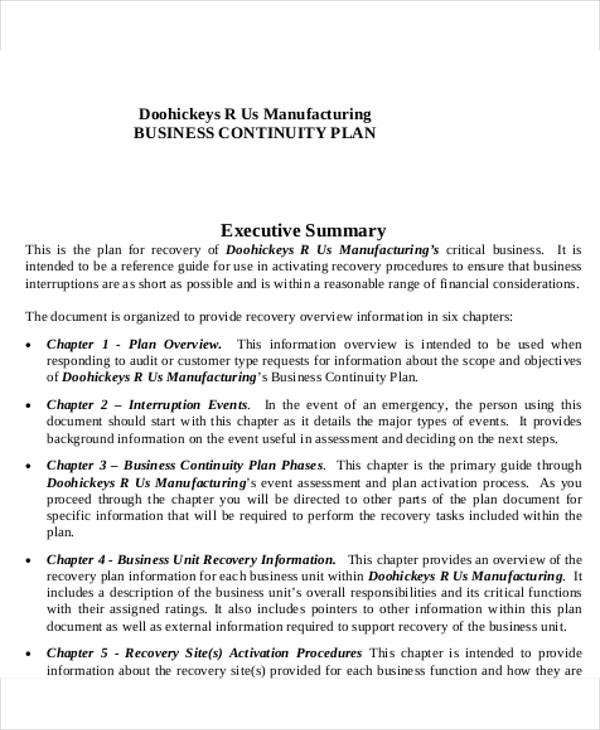
What Goes into a Manufacturing Business Plan?
- Executive summary . Here is where you condense your business’s intended purposes and goals. What is your mission-vision statement?
- Company description. Define the nature of your intended business, the commodities you are producing, where you will be located, etc.
- Market analysis . Where do you fit in the larger economy and what your relationship will be to existing businesses and competition? Define your target market and your role in fulfilling a real economic need.
- Strategy and implementation. Here you propose your methodology to achieve your goals.
- Management and organization. Assign your founding team and determine its structure and member responsibilities.
- Financial plan and projections. Estimate a budget and forecast your earnings.
- See also Manufacturing Business Marketing Plan to go from production to marketing.
- Also, see Manufacturing Business Continuity Plan above to establish a sustainable company.
Garment Manufacturing Business Plan Template

Furniture Manufacturing Business Plan Template

Manufacturing Business Marketing Plan Template
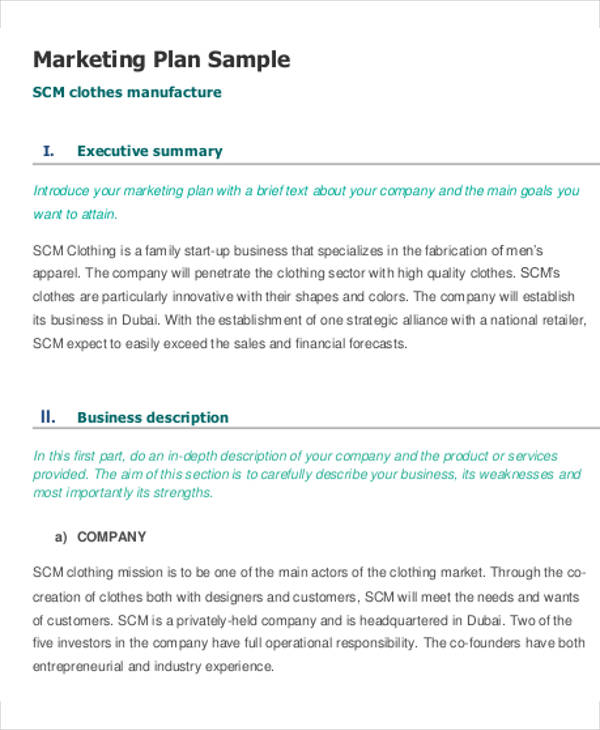
Manufacturing and Operation Plan Template
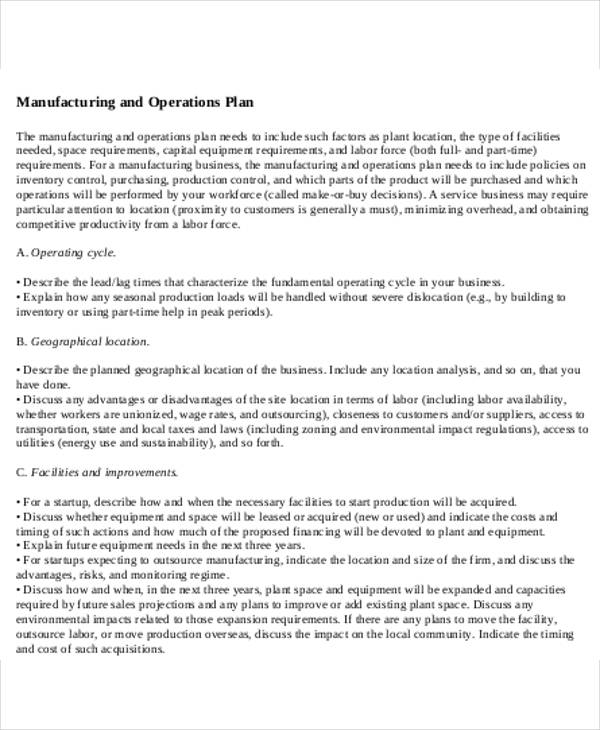
How to Use These Plan Templates
- They will give you the outline of an effective, comprehensive, and adequately detailed business plan.
- They will provide key insights into the real considerations you have to take into account per business type.
General FAQs
1. what is the manufacturing business plan, 2. what are the components of a manufacturing business plan.
- Executive Summary
- Business Description
- Products and Services
- Market Research
- Sales & Marketing
- Operations Financials.
3. What is the Purpose of a Manufacturing Business Plan?
4. who should your manufacturing business plan convince, 5 what are the different types of manufacturing businesses.
- Food, Beverage, and Tobacco
- Textiles, Leather, and Apparel
- Wood, Paper, and Printing
- Petroleum and Coal
- Chemicals, Plastics, and Rubber
- Metals and Machinery
- Computer and Electronics.
More in Plan Templates
Functional Resume Template
Resume application template, sample swimming coach & instructor resume template, sample deaf sign language teacher resume template, fancy cv template, classic cv template, plain cv template, attractive cv template, cfo cv template, nursing cv template.
- 7+ Financial Plan Templates
- 10+ Operational Plan Templates
- 9+ Training Plan Templates
- 5+ Shooting Schedule Template
- 11+ School Counselor Lesson Plan Templates in PDF | Word
- 9+ Interdisciplinary Lesson Plan Templates in PDF | MS Word
- 10+ Business Continuity Plan Templates in Google Docs | Ms Word | Pages | PDF
- 18+ Compensation Plan Templates in Google Docs | MS Word | Pages | PDF
- 10+ Executive Bonus Plan Templates in PDF
- 8+ Facility Management Plan Templates in PDF
- 10+ Diversity Recruitment Plan Templates in PDF | MS Word
- 11+ Audit Corrective Action Plan Templates in MS Word | Excel | PDF
- 9+ Recruitment Agency Marketing Plan Templates in PDF
- 10+ Recruitment Marketing Plan Templates in PDF | MS Word
- 10+ Student Recruitment Plan Templates in PDF | MS Word
File Formats
Word templates, google docs templates, excel templates, powerpoint templates, google sheets templates, google slides templates, pdf templates, publisher templates, psd templates, indesign templates, illustrator templates, pages templates, keynote templates, numbers templates, outlook templates.

Manufacturing Business Plan Template [Updated 2024]
Manufacturing Business Plan Template
If you want to start a Manufacturing business or expand your current Manufacturing company, you need a business plan.
The following Manufacturing business plan template gives you the key elements to include in a winning Manufacturing business plan.
You can download our business plan template (including a full, customizable financial model) to your computer here.
Below are links to each of the key sections of a sample manufacturing business plan. Once you create your plan, download it to PDF to show banks and investors.
I. Executive Summary II. Company Overview III. Industry Analysis IV. Customer Analysis V. Competitive Analysis VI. Marketing Plan VII. Operations Plan VIII. Management Team IX. Financial Plan
Comments are closed.
Manufacturing Business Plan Home I. Executive Summary II. Company Overview III. Industry Analysis IV. Customer Analysis V. Competitive Analysis VI. Marketing Plan VII. Operations Plan VIII. Management Team IX. Financial Plan

- Business planning and strategy
Manufacturing Business: Business Plan Example
Are you setting up a manufacturing business? We’ve created an example business plan to help you get started.
Are you manufacturing goods from home? Want to move to the next level and ramp up your business’ production? Starting to write a business plan will help you identify your markets, outline potential risks and understand the cash flow for your business.
To help you get started we’ve created an example business plan for the manufacturing industry. Our example focuses on producing high quality leather accessories, but it will work as a framework regardless of the specific business you are considering. Click the Download button to gain access to the word document.
Good luck and happy writing!
Related resources

- Entrepreneurship

Need a business plan? Call now:
Talk to our experts:
- Business Plan for Investors
Bank/SBA Business Plan
- Operational/Strategic Planning
- L1 Visa Business Plan
- E1 Treaty Trader Visa Business Plan
- E2 Treaty Investor Visa Business Plan
- EB1 Business Plan
- EB2 Visa Business Plan
- EB5 Business Plan
- Innovator Founder Visa Business Plan
- UK Start-Up Visa Business Plan
- UK Expansion Worker Visa Business Plan
- Manitoba MPNP Visa Business Plan
- Start-Up Visa Business Plan
- Nova Scotia NSNP Visa Business Plan
- British Columbia BC PNP Visa Business Plan
- Self-Employed Visa Business Plan
- OINP Entrepreneur Stream Business Plan
- LMIA Owner Operator Business Plan
- ICT Work Permit Business Plan
- LMIA Mobility Program – C11 Entrepreneur Business Plan
- USMCA (ex-NAFTA) Business Plan
- Franchise Business Planning
- Landlord Business Plan
- Nonprofit Start-Up Business Plan
- USDA Business Plan
- Cannabis business plan
- eCommerce business plan
- Online Boutique Business Plan
- Mobile Application Business Plan
- Daycare business plan
- Restaurant business plan
- Food Delivery Business Plan
- Real Estate Business Plan
- Business Continuity Plan
- Buy Side Due Diligence Services
- ICO whitepaper
- ICO consulting services
- Confidential Information Memorandum
- Private Placement Memorandum
- Feasibility study
- Fractional CFO
- How it works
- Business Plan Examples
How To Write A Textile Manufacturing Business Plan
Published Mar.29, 2024
Updated Apr.23, 2024
By: Alex Silensky
Average rating 5 / 5. Vote count: 2
No votes so far! Be the first to rate this post.

Table of Content
Textile Manufacturing Business Plan Sample
According to a report by Grand View Research, the global textile market size was valued at USD 1.25 trillion in 2023 and might reach USD 1.84 trillion in 2030. In this booming sector, preparing a professional textile manufacturing business plan is not just a formality; it’s a strategic move that can determine the success or failure of your venture.
This article is crucial for entrepreneurs who aim to enter the textile market. By the end of this article, you will have a clear understanding of how to write a business plan for the textile industry and its key components, including:
Executive Summary
Company overview, industry analysis, customer analysis, competitive analysis, marketing plan, operations plan, financial plan.
We will use FabriCo as a sample textile manufacturing business as a practical example. This will give you a clear understanding of what a textile manufacturing business plan looks like, and you’ll be able to use FabriCo’s textile business plan template for your business. You can also refer to our fabric store business plan here.
Business Overview
Name: FabriCo
Location: Los Angeles, California
Legal Structure: Limited Liability Company (LLC)
Mission: To produce high-quality, eco-friendly, and affordable textile products for the domestic and international markets
Vision: To become a leading textile manufacturer and exporter in the US and beyond
Objectives: To achieve the following goals in the next five years:
- Increase annual revenue by 20%
- Expand production capacity by 50%
- Diversify product portfolio by adding new categories and designs
- Enter new markets in Europe, Asia, and Africa
- Enhance brand awareness and customer loyalty
FabriCo’s products are divided into two main categories:
FabriCo produces fabrics using various types of natural and synthetic fibers. FabriCo also creates fabrics with different patterns, colors, textures, and finishes as explained in our clothing retail business plan . FabriCo’s fabrics are categorized into four segments:
- Basic fabrics
- Premium fabrics
- Luxury fabrics
- Eco-friendly fabrics
2. Garments
FabriCo manufactures garments using its own fabrics. FabriCo can produce various types of garments for:
FabriCo also offers services such as:
- Sewing (use our sewing business plan )
- Embroidery (use our embroidery business plan )
- Embellishment
- Quality control.
FabriCo’s garments are categorized into three segments:
- Casual garments
- Formal garments
- Custom garments
Customer Focus
FabriCo’s target customers are fashion brands, retailers, and wholesalers looking for high-quality, sustainable, and innovative fabrics and garments for their collections.
FabriCo’s target customers are mainly located in the US and Europe, where the demand for textile products is high, and the awareness of environmental and social issues is increasing.
FabriCo’s target customers are segmented into four groups:
- Small and medium-sized fashion brands
- Large and established fashion brands
- Fashion retailers and wholesalers
- Eco-friendly and ethical fashion brands, retailers, and wholesalers

Management Team
FabriCo’s management team consists of the following key members:
- Emily Thompson, CEO and Founder
- David Wong, Chief Operating Officer
- Jessica Lee, Creative Director
Success Factors
Success factors are the areas that FabriCo will focus on and excel at, and that will differentiate FabriCo from its competitors. FabriCo’s success factors are:
- Eco-friendly production processes
- Sustainable sourcing
- Innovative textile designs
- Cutting-edge technology
- Strong partnerships with fashion brands and retailers
- Efficient supply chain and operations
- Commitment to ethical labor practices and social responsibility
Financial Highlights
FabriCo has a solid and profitable financial performance, as shown by the following financial highlights:
- Generate $1.2 million in revenue in the first year of operation, growing at a CAGR of 25% to reach $2.4 million in the third year.
- Achieve a gross profit margin of 50% in the first year of operation, increasing to 54% in the third year.
- Achieve an operating profit margin of 25% in the first year of operation, increasing to 33% in the third year.
- Achieve a net profit margin of 20% in the first year of operation, increasing to 27% in the third year.

Who is FabriCo?
FabriCo is a textile manufacturing company founded in 2024 by Emily Thompson. The mission is to produce:
- High-quality
- Eco-friendly
- Innovative fabrics for various industries and customers.
The company’s vision is to become a leader and a pioneer in the textile industry by offering products and services that are superior, sustainable, and creative.
FabriCo Textile History
2020 – Emily and David met at a textile conference and decided to start a business together.
2021 – Developed a smart e-textile business plan and a prototype of their products.
2022 – Secured funding from angel investors and venture capitalists.
2023 – Leased a warehouse and machinery in Los Angeles, California.
2024 – Launched their products and services and started selling fabrics and garments.
The global textile manufacturing industry is a multi-billion dollar market. According to a report by Mordor Intelligence:
- The Textile Market size is estimated at USD 748 billion in 2024
- It is expected to reach USD 889.24 billion by 2029
- The CAGR is estimated to be 3.52% during the forecast period (2024-2029)

Image Source: Mordor Intelligence
The textile industry is influenced by several factors, such as:
- Raw material availability and prices
- Labor costs and availability of skilled labor
- Technological advancements
- Consumer preferences and fashion trends
- Environmental regulations and sustainability concerns
- Trade policies and international trade agreements
Demographic Profile of Target Market
FabriCo’s target market consists of customers interested in buying high-quality, eco-friendly, and innovative fabrics for various purposes and applications. The demographic profile of FabriCo’s target market is:
| Age | 25-54 years old |
| Gender | Primarily female-led brands and designers |
| Income | Middle to high-income ($50,000 to $200,000 or above) |
| Education | College degree or higher |
| Location | Urban and suburban areas |
| Lifestyle | Eco-conscious, socially responsible, health-conscious |
| Values | Prioritize sustainability, ethical practices, transparency |
Customer Segmentation
FabriCo’s customer base is segmented into the following groups:
- Fashion Brands: Includes eco-friendly fashion labels, designer brands, and apparel retailers that prioritize sustainable and ethically produced textiles.
- Home Furnishing Retailers: Includes home furnishing stores, interior design firms, and retailers that offer eco-friendly home textiles.
- Conscious Consumers: Includes environmentally conscious individuals and prefer to purchase sustainable and ethically produced products.
Table: Demographic Data
| Fashion Brands | 25-45 | Male & Female | $60,000 – $150,000 | Urban areas |
| Home Furnishing Retailers | 35-55 | Male & Female | $80,000 – $200,000 | Suburban areas |
| Conscious Consumers | 25-45 | Female | $50,000 – $120,000 | Urban and suburban areas |
Direct and Indirect Competitors
FabriCo faces competition from direct and indirect competitors who offer similar or substitute products and services in the textile industry. Some of the main competitors are:
Direct Competitors
Direct competitors produce and sell fabrics for the same or similar industries and customers as FabriCo. Some of the direct competitors are:
1. TextiCo (Los Angeles, CA)
TextiCo is a well-established player in the sustainable textile manufacturing industry, headquartered in Los Angeles. TextiCo specialize in producing a range of eco-friendly fabrics for the fashion and apparel market.
- Long-standing reputation in the industry
- Diverse product portfolio catering to various market segments
- Established relationships with major fashion brands
- Perceived as a more traditional player, lacking innovation
- Limited focus on cutting-edge fabric technologies
- Relatively higher production costs due to legacy systems
2. Fabrica (Portland, OR)
Fabrica is a leading manufacturer of sustainable textiles based in Portland, Oregon. They specialize in producing high-performance fabrics from recycled and biodegradable materials, primarily targeting the activewear and athleisure markets.
- Cutting-edge research and development capabilities
- Strong focus on performance and functional fabrics
- Established partnerships with leading activewear brands
- Limited product offerings for the high-end fashion market
- Relatively smaller scale of operations compared to larger competitors
- Geographical concentration in the Pacific Northwest region
Indirect Competitors
Indirect competitors produce and sell fabrics for different or complementary industries and customers as FabriCo. Some of the indirect competitors are:
1. Traditional Textile Manufacturers
Traditional manufacturers have been operating in the industry for decades, producing fabrics using conventional materials and processes. While they may not specifically focus on sustainable textiles, they offer alternative fabric options for various market segments.
- Large production capacities and global reach
- Diversified product offerings catering to various industries
- Established relationships with major brands and retailers
- Perceived as less environmentally friendly due to traditional manufacturing processes
- Slower adaptation to sustainable practices and consumer trends
- Limited focus on innovative and specialized fabric solutions
2. Imported Fabrics from Overseas Markets (e.g., China, India)
Textile manufacturing is a significant industry in many overseas markets, where fabrics are produced at lower costs and exported globally. While not necessarily focused on sustainability, these imported fabrics can compete on price and availability.
- Cost advantages due to lower labor and production costs
- Ability to quickly scale production to meet high-volume demands
- Access to diverse raw materials and manufacturing capabilities
- Longer lead times and potential supply chain disruptions
- Varying quality standards and limited transparency
- Potential challenges in adhering to sustainable and ethical practices
Competitive Advantage
FabriCo highly focuses on sustainability and innovation. FabriCo differentiates itself through the following strengths:
- Advanced Technology – FabriCo invests heavily in modern technology that minimizes environmental impact while ensuring superior product quality.
- Innovative Material Sourcing – FabriCo uses renewable and recycled materials and new sustainable fibers.
- Strong Partnerships – FabriCo has established strategic partnerships with suppliers, ensuring a reliable and responsible supply chain.
- Continuous Research and Development – FabriCo’s in-house research team continuously explores new fabric solutions to stay ahead of market trends.
- Exceptional Customer Service – FabriCo prioritizes building strong customer relationships and offering personalized support.
Promotions Strategy
FabriCo’s promotional strategy is to raise awareness, generate interest, and increase sales of its products and services. FabriCo’s promotions strategy consists of the following tactics:
1. Digital Marketing
- Social media campaigns
- Influencer collaborations with sustainable fashion influencers
- Targeted online advertising campaigns
- Content marketing
2. Trade Shows and Exhibitions
- Participation in key industry events
- Showcasing products and networking
- Organizing product demonstrations and seminars
3. Strategic Partnerships
- Collaborations with like-minded organizations, influencers, and industry associations
- Co-marketing campaigns and cross-promotions
- Sponsorships and endorsements
4. Sustainable Fashion Events
- Organizing or sponsoring eco-friendly fashion shows
- Engaging with the local sustainable fashion community
- Showcasing our products and thought leadership
5. Public Relations
- Press releases and media outreach
- Guest articles and interviews in industry publications
- Speaking opportunities at relevant conferences and events
FabriCo’s total annual marketing budget is $400,000 , 8% of its projected revenue for the first year. FabriCo’s marketing budget will be used as follows:

FabriCo’s pricing strategy is to offer competitive and value-based prices for its products and services. FabriCo’s prices vary depending on the products and services type, quantity, and quality. The average prices are:
- Cotton fabrics: $10 per yard
- Synthetic fabrics: $8 per yard
- Blended fabrics: $9 per yard
- Design service: $100 per hour
- Customization service: $50 per hour
- Delivery service: $20 per order
Operation Functions
FabriCo’s operations are designed to ensure efficient and sustainable textile manufacturing processes. FabriCo’s operation functions include:
1. Sourcing
- Identifying and selecting the best suppliers
- Negotiating the terms and prices
- Maintaining a good relationship and communication
- Receiving and inspecting the materials
2. Production
- Spinning the fibers into yarns
- Knitting or weaving the yarns into fabrics
- Dyeing the fabrics using environmentally friendly dyes
- Finishing the fabrics using finishing machines and treatments
- Testing the fabrics for quality, durability, and performance
- Generating and developing design concepts
- Presenting and discussing the designs with the customers
- Revising and finalizing the designs according to the feedback
4. Customization
- Understanding and analyzing the customer’s needs
- Using techniques and treatments to enhance the fabrics
- Checking and confirming the quality and accuracy
- Delivering the customized fabrics, if needed
5. Delivery
- Packing the fabrics in secure packages
- Labeling the packages properly
- Shipping the packages using the chosen method
- Receiving and verifying the delivery confirmation and feedback
FabriCo’s milestones are the goals and objectives that company aims to achieve in the short-term and long-term. FabriCo’s milestones for the next two years are:
| Q1 2024 | Official launch of FabriCo’s online store and first product line |
| Q2 2024 | Achieve break-even point |
| Q3 2024 | Introduce a second line of eco-friendly fabrics |
| Q4 2024 | Expand production capacity by 25% |
| Q1 2025 | Launch a partnership program with fashion designers |
| Q2 2025 | Begin international shipping to select countries |
| Q3 2025 | Open a physical showroom in Los Angeles for B2B clients |
| Q4 2025 | Introduce a recycling program for fabric scraps |
Key Revenue & Costs
FabriCo’s key revenue will come from:
- Fabric Sales: Primary source of revenue, projected to account for 80% of total revenue.
- Custom Design Services: Offering bespoke design solutions, estimated to contribute 10% of revenue.
- Consultation Services: Providing industry expertise, expected to generate 5% of revenue.
- Workshops and Training: Hosting educational events, potentially bringing in 3% of revenue.
- Licensing and Partnerships: Collaborating with other brands that could account for 2% of revenue.
FabriCo’s key cost includes:
1. Startup Costs
- Acquisition of manufacturing equipment and facility setup
- Initial working capital and inventory
- Initial research
- Branding and marketing
2. Fixed Costs
- Rent or lease payments
- Salaries and benefits for employees
- Insurance premiums
- Administrative expenses
3. Variable Costs
- Raw material procurement
- Packaging and labeling materials
- Shipping and logistics costs
- Sales commissions or incentives
- Marketing and promotion
- Development expenses
Funding Requirements and Use of Funds
Funding requirements: FabriCo requires $1.5 million to start and operate its business. FabriCo has secured $1 million in funding from angel investors and venture capitalists and is seeking another $500,000 from banks and other sources.
Use of funds: FabriCo plans to use the funds for the following purposes:
| Equipment and machinery | $500,000 |
| Raw materials and inventory | $300,000 |
| Rent and utilities | $200,000 |
| Labor and salaries | $200,000 |
| Marketing and advertising | $100,000 |
| Research and development | $100,000 |
| Legal and accounting | $50,000 |
| Contingency | $50,000 |
Key Assumptions
FabriCo’s assumptions are based on market research, industry trends, and our strategic plan, providing a solid foundation for our financial projections:
- 20% year-over-year increase in sales volume.
- 5% annual increase in the cost of raw materials and overheads.
- Inventory turnover ratio of 6 times per year.
- Averaging 45 days for the collection of receivables.
- Allocating 10% of annual profits towards capital investments.
- Interest rates on borrowed capital are assumed to be at 7% annually.
- Corporate tax rate is assumed to be 25% of pre-tax profits.
Financial Projections
FabriCo’s financial projections are the forecasts and calculations of its financial performance and position. FabriCo’s financial projections include:
- Projected Income Statement
- Projected Balance Sheet
- Projected Cash Flow Statement
Need Help with Your Textile Manufacturing Business Plan? OGSCapital Can Help
At OGSCapital, we pride ourselves on our extensive experience and deep expertise in crafting bespoke business plans like the maternity clothing business plan . We understand how much it costs to start a textile manufacturing venture, and we’re here to guide you through every step.
We go beyond templates and generic software to provide personalized strategies, in-depth market research, and financial projections that align with your objectives. Our expertise lies in transforming your entrepreneurial ideas into compelling textile recycling business plans that attract investors and secure funding.
Contact Us today, and let’s create a business plan that sets you up for success.
Frequently Asked Questions
Are textiles profitable?
Textile manufacturing is a profitable industry, with the global market size valued at USD 993.6 billion in 2021 and expected to grow at a compound annual growth rate of 4.0% from 2022 to 2030.
What are examples of textile businesses?
Textile businesses encompass a wide range of companies, including Milliken & Company, Hanesbrands Inc., Culp Inc., Burlington Industries, Glen Raven Inc., W.L. Gore & Associates, and more.
OGSCapital’s team has assisted thousands of entrepreneurs with top-rate business plan development, consultancy and analysis. They’ve helped thousands of SME owners secure more than $1.5 billion in funding, and they can do the same for you.

Ice Vending Machine Business Plan

OGScapital at the National Citizenship and Immigration Conference

How to Start a Plumbing Business in 2024: A Detailed Guide

Vegetable Farming Business Plan

Trading Business Plan

Any questions? Get in Touch!
We have been mentioned in the press:
Leave a Reply Cancel reply
Your email address will not be published. Required fields are marked *
Save my name, email, and website in this browser for the next time I comment.
Search the site:

300+ Business Plan Examples

With over two decades of experience, Growthink has assisted more than 1 million companies in developing effective business plans to launch and expand their businesses. Trust in our expertise to guide you through developing a business plan that drives your success. In addition to our sample plans, below you’ll learn the answers to key business plan questions and gain insightful tips on writing your business plan.
Quick Links to Sections On this Page:
- Sample Business Plans By Business Category
Answers to Key Sample Business Plan Questions
Shoutmouth business plan example, business plan examples by business category.
Clothing & Fashion Business Plan Templates & Samples
Clothing Store Business Plan
Embroidery Business Plan
Fashion Business Plan
Jewelry Business Plan
Construction, Interior Design & Home Services Business Plan Templates & Samples
|
|
|
Consumer Services Business Plan Templates & Samples
|
|
|
Business Services Business Plan Templates & Samples
|
|
|
Events Business Plan Templates & Samples
Banquet Hall Business Plan
Event Planning Business Plan
Event Venue Business Plan
Sample Event Venue Business Plan
Party Rental Business Plan
Photo Booth Business Plan
Table and Chair Rental Business Plan
Wedding Planning Business Plan
Farm Business Plan Templates & Samples
|
|
|
Financial Services Business Plan Templates & Samples
|
|
|
Fitness & Beauty Business Plan Templates & Samples
|
|
|
Food & Beverage Business Plan Templates & Samples
|
|
|
Medical & Health Business Plan Templates & Samples
|
|
|
Music & Entertainment Business Plan Templates & Samples
Music Business Plan
Party Bus Business Plan
Podcast Business Plan
Production Company Business Plan
Record Label Business Plan
Recording Studio Business Plan
Nonprofit Business Plan Templates & Samples
Sample Non-Profit Business Plan
Charity Business Plan
Sample Nonprofit Business Plan PDF
Social Enterprise Business Plan
Real Estate Business Plan Templates & Samples
Sample Airbnb Business Plan
House Flipping Business Plan
Property Development Business Plan
Property Management Business Plan
Real Estate Business Plan
Real Estate Agent Business Plan
Real Estate Business Plan PDF
Real Estate Development Business Plan
Real Estate Investment Business Plan
Retail & Ecommerce Business Plan Templates & Samples
|
|
|
Technology Business Plan Templates & Samples
Biodiesel Business Plan
Blogging Business Plan
Clean Tech Business Plan
Mobile App Business Plan
Saas Business Plan
Software Company Business Plan
Technology Business Plan
Transportation Business Plan Templates & Samples
|
|
|

Travel and Lodging Business Plan Templates & Samples
Bed and Breakfast Business Plan
Campground Business Plan
Glamping Business Plan
Hotel Business Plan
Mobile Home Park Business Plan
Resort Business Plan
RV Park Business Plan
Travel Agency Business Plan
1. Why is utilizing an example business plan a good idea?
Sample business plans can help you quickly and easily write a business plan for your own business. Business plans are an important tool for any business, but they can be challenging to create. A sample business plan will help you understand the business plan format , the benefit of market research, and how to write a compelling executive summary. It can also serve as a guide for creating your own business plan, outlining the key sections and providing examples of successful plans. Utilizing the best business plan template can save you time and ensure that your plan is well-structured and comprehensive.
Business plan examples may even help you with the different sections of a plan, including market analysis, business description, cash flow statements/business financial statements, and more. Business plans can also show you how a quality plan in your exact business plan category is organized and shows you the appropriate business communications style to use when writing your business plan.
2. Who would benefit from using an example business plan?
Any entrepreneur or business owner who has never written a business plan before can benefit from an example or sample plan. New business owners often start with business plan templates , which are helpful but are sometimes more useful after reviewing other sample business plans.
A good sample plan can be a step-by-step guide as you work on your business planning and business idea. Once you have a sense for the flow, specs, and details, etc. that business plans have, utilizing a business plan template will help you pull everything together, helping you create a plan investors and other stakeholders will value. A solid business plan will also help you if you need a bank loan, which may require a startup business plan. Download our free business plan template to help you get started on your own business plan.
Free Download : Free Business Plan Template PDF
3. How do you get started with a sample business plan and maximize its benefit?
First you should read the business plan thoroughly. Study both the type of information provided in key sections like the executive summary, target market analysis, summary, etc., as well as the format and style of the plan. As you read, you may find yourself thinking through things such as improving or evaluating your business planning process, your business idea, or reconsidering who you want to write your business plan for. This is OK and part of the process. In fact, when you start writing a business plan for the first time, it will be much easier because you’ve gone through this process.
After this initial read, outline your business plan and copy in from the sample plan sections that apply to your business. For instance, if the sample plan included public relations in their marketing strategy and sales plan, and you will also use this tactic, you can copy it into your plan and edit it as appropriate. Finally, answer the other questions answered in the sample plan in ways that reflect your unique business and target customers.
Writing a business plan can seem daunting. Starting your business plan writing process by reviewing a plan that’s already been created can remove a lot of mental and emotional barriers while helping you craft the best plan you can.
4. When should you not use a sample business plan?
If your business is unlike any other, using a sample business plan will not be as effective. In this situation, writing a business plan from scratch utilizing a business plan template is probably your best path forward.
As an example, Facebook’s early business plan was unlike others since it was paving a new path and way of doing business. But, groundbreaking new businesses like Facebook are not the norm, and the vast majority of companies will benefit from utilizing sample business plans.
5. How do you choose the right type of business plan for your venture?
Selecting the appropriate type of business plan depends on your business’s stage, needs, and goals. Let’s explore the different types of business plans and how to determine which business plan format is right for you.
- Startup Business Plan : This type of plan is for businesses just starting out and seeking funding or investment. It typically includes a detailed analysis of the market, target audience, competition, and financial projections.
- Traditional Business Plan : Traditional business plans are the most common type of business plan, used by established businesses to outline their goals and strategies. It includes all the key sections such as market analysis, company description, and financial statements.
- Internal Business Plan : Internal business plans are used for internal purposes, to guide the day-to-day operations and decision making of the business. It may not be as detailed as a traditional business plan, but still includes important information such as company mission, objectives, and key performance indicators.
- Feasibility Business Plan : A feasibility business plan is used to assess the viability of a new product or service in the market. It includes detailed research and analysis to determine if the business idea is feasible and profitable.
- One-Page Business Plan : As the name suggests, this type of business plan is condensed into one page and includes the most critical information about the business. It can be a useful tool for pitching to potential investors or partners.
- Strategic Business Plan : A strategic plan looks at the big picture and long-term business goals of a company. It may include the company’s mission statement, core values, and overarching strategies for achieving success.
Ultimately, the type of business plan you choose will depend on your business’s specific needs and goals. It may also be beneficial to combine elements from different types of plans to create a customized plan that best fits your business. Carefully consider your objectives and resources before deciding on the right type of plan for your venture.
Finish Your Business Plan in 1 Day!
Don’t you wish there was a faster, easier way to finish your business plan?
With Growthink’s Ultimate Business Plan Template you can finish your plan in just 8 hours or less!
The business plan example below is for Shoutmouth, a company that enjoyed much success in the early 2000’s and which was able to raise funding. While the plan’s premise (social networking) is not as unique now as it was then, the format and structure of this business plan still holds.
I. Executive Summary
Business Overview
Launched in late February 2007, Shoutmouth.com is the most comprehensive music news website on the Internet .
Music is one of the most searched and accessed interests on the Internet. Top music artists like Akon receive over 3 million searches each month. In addition, over 500 music artists each receive over 25,000 searches a month.
However, music fans are largely unsatisfied when it comes to the news and information they seek on the artists they love. This is because most music websites (e.g., RollingStone.com, MTV.com, Billboard.com, etc.) cover only the top eight to ten music stories each day – the stories with mass appeal. This type of generic coverage does not satisfy the needs of serious music fans. Music fans generally listen to many different artists and genres of music. By publishing over 100 music stories each day, Shoutmouth enables these fans to read news on all their favorite artists.
In addition to publishing comprehensive music news on over 1200 music artists, Shoutmouth is a social network that allows fans to meet and communicate with other fans about music, and allows them to:
- Create personal profiles
- Interact with other members
- Provide comments on news stories and music videos
- Submit news stories and videos
- Recommend new music artists to add to the community
- Receive customized news and email alerts on their favorite artists
Success Factors
Shoutmouth is uniquely qualified to succeed due to the following reasons:
- Entrepreneurial track record : Shoutmouth’s CEO and team have helped launch numerous successful ventures.
- Affiliate marketing track record : Online affiliate marketing expertise has been cited as one of MySpace’s key success factors. Over the past two years, Shoutmouth’s founders have run one of the most successful online affiliate marketing programs, having sold products to over 500,000 music customers online.
- Key milestones completed : Shoutmouth’s founders have invested $500,000 to-date to staff the company (we currently have an 11-person full-time team), build the core technology, and launch the site. We have succeeded in gaining initial customer traction with 50,000 unique visitors in March, 100,000 unique visitors in April, and 200,000 unique visitors in May 2007.
Unique Investment Metrics
The Shoutmouth investment opportunity is very exciting due to the metrics of the business.
To begin, over the past two years, over twenty social networks have been acquired. The value in these networks is their relationships with large numbers of customers, which allow acquirers to effectively sell to this audience.
The sales price of these social networks has ranged from $25 to $137 per member. Shoutmouth has the ability to enroll members at less than $1 each, thus providing an extraordinary return on marketing expenditures. In fact, during an April 2007 test, we were able to sign-up 2,000 members to artist-specific Shoutmouth newsletters at a cost of only 43 cents per member.
While we are building Shoutmouth to last, potential acquirers include many types of companies that seek relationships with music fans such as music media/publishing (e.g., MTV, Rolling Stone), ticketing (e.g., Ticketmaster, LiveNation) and digital music sales firms (e.g., iTunes, The Orchard).
Financial Strategy, Needs and Exit Strategy
While Shoutmouth’s technological, marketing and operational infrastructure has been developed, we currently require $3 million to execute on our marketing and technology plan over the next 24 months until we hit profitability.
Shoutmouth will primarily generate revenues from selling advertising space. As technologies evolve that allow us to seamlessly integrate music sampling and purchasing on our site, sales of downloadable music are also expected to become a significant revenue source. To a lesser extent, we may sell other music-related items such as ringtones, concert tickets, and apparel.
Topline projections over the next three years are as follows:
| 2007 | 2008 | 2009 | |
| Shoutmouth Members | 626,876 | 4,289,580 | 9,577,020 |
| Unique Visitors | 2,348,050 | 8,390,187 | 18,633,659 |
| Total Page Views (Millions) | 20.7 | 273.5 | 781.0 |
| Revenues | $165,431 | $2,461,127 | $7,810,354 |
| Expenses | $1,407,958 | $2,591,978 | $2,838,423 |
| EBITDA | ($1,242,527) | ($130,851) | $4,971,931 |
II. Shoutmouth Overview
What is Shoutmouth?
Shoutmouth is an operating company of The Kisco Group Inc. (TKG). Since 2003, TKG has capitalized on web-based marketing opportunities via launching targeted websites and generating web-based leads. TKG revenues in 2005 exceeded $1.3 million and grew to $3.5 million in 2006. Shoutmouth is currently the sole focus of TKG; all other TKG business units have been divested.
Development of Shoutmouth began in August 2006 and the site officially launched on February 21, 2007. Shoutmouth (located at www.shoutmouth.com) is the most comprehensive music news community on the Internet. The website covers 1,200 popular bands and music artists and offers more than 100 new music articles each day. In addition to providing news, Shoutmouth is a web community. That is, Shoutmouth members can actively participate on the site, by doing things such as commenting on news stories and submitting their own stories.
The Market Size and Need for Shoutmouth
The music market is clearly vast. According to IFPI, which represents the recording industry worldwide, global music sales were $33.5 billion in 2005, with the U.S. accounting for $12.3 billion of that amount. Importantly, digitally music sales are seeing substantial growth, with IFPI reporting sales of $400 million in 2004, $1.1 billion in 2005 and $2 billion in 2006.
Online, music is the one of the most frequently searched and accessed interests. For example, according to Wordtracker, the music artist Eminem received over 1.7 million web searches in December 2006, while band Green Day received 534,000 searches.
To put these figures in perspective, top celebrities in other entertainment fields receive but a fraction of this search volume. For example, December 2006 search volumes for select sports stars and actors were as follows: Kobe Bryant, 122K; Tiger Woods, 88K; Cameron Diaz, 332K; and Tom Cruise, 82K.
Conversely, 225 music artists received over 100,000 searches in December 2006, and over 500 music artists received over 25,000 searches.
This data is corroborated by Nielsen BuzzMetrics which plots the most popular topics bloggers are posting about. The chart to the right plots September 25, 2006 to March 25, 2007 and shows how music dominates other entertainment sectors online.
When searching for music artists online, fans, which are primarily between the ages of 13 and 35, are looking for news, pictures, lyrics, videos and audio files. In addition, fans enjoy publicly voicing their opinions about music and interacting with other fans.
There is currently no website besides Shoutmouth that provides comprehensive music news. Currently, to get the latest news on their favorite artists, fans must visit the official websites or fan websites of each of the artists they like . Even then, it is unlikely that the fan will get all the news that has occurred. To solve this problem, Shoutmouth scours the web and uncovers news from thousands of web sites.
What Shoutmouth Does and Will Offer
As of May 2007, the site covers the 1,200 most popular music artists (popularity primarily based on the number of web searches over the past 12 months for each artist).
Shoutmouth currently offers members the ability to:
- Read over 500 new music articles each week
- Read special features such as album reviews, interviews, new album release dates, top quotes of the week and other special reports
- Watch and rate music videos
- Listen to select music audio clips
- Comment on news stories and music videos
- Submit news stories that they see/hear of elsewhere
- Suggest new music artists to add to the site
- View articles by music artist or by genre (current genres include Rock, Pop, Rap, R&B, Country, and Electronic)
- Create a user profile that includes their favorite music artists, Shoutmouth friends, news stories submitted to Shoutmouth, and comments made. Members have the ability to find other members based on their favorite artists and via our search functions.
- Receive customized news and email alerts. Members can customize their “My News” page to include only artists they specify. Likewise, they can choose to receive email alerts whenever there is a new story on one of their favorite artists.
While establishing itself as the premier music news community, Shoutmouth will embark on the more aggressive goal of becoming the premier music community online . To accomplish this, Shoutmouth will begin to offer additional content (more videos, audio, pictures, lyrics, etc.) and additional functionality (music compatibility testing (e.g., if you like this, you’ll like this), voting capabilities, member-to-member messaging, etc.). We have already begun mapping out our content and technology growths plans to achieve this goal upon financing.
Importantly, Shoutmouth expects to be able to add massive amounts of relevant content (e.g., lyrics, reviews, pictures, video files, audio files, etc.) via member submissions and moderation. This is the same way that YouTube has been able to quickly add millions of videos and Wikipedia has been able to add millions of articles. Importantly, since established music websites (e.g., MTV, RollingStone.com, Billboard.com, etc.) are not community based, they would have to hire thousands of staff members to rival the content that Shoutmouth will have.
How We Get and Publish Our News
Currently, news stories that appear on Shoutmouth are gathered from numerous online sources. Shoutmouth’s staff writers find these stories by using RSS and News feeds that cover thousands of websites. In addition, Shoutmouth community members have the ability to submit stories they find elsewhere.
Typical stories include factual information plus the insight of the author. Shoutmouth editors ensure that all stories are properly classified by artist and genre, and that duplicate articles are filtered out.
Over the past three months, Shoutmouth has developed a solid infrastructure, which we consider a core competitive advantage, that that allows us to provide comprehensive music news . This infrastructure includes:
- Setting up hundreds of RSS feeds based on comprehensive research regarding sites from which to receive feeds
- Training our editorial team regarding identifying a story and weeding out duplicates
- Assigning music artists among our five-person editorial team to better manage work flow and avoid duplicate articles
We are working on a system to ensure that member-submitted articles are automatically routed to the appropriate member of Shoutmouth’s editorial team to improve our efficiencies further.
Shoutmouth’s Goal to Break News First
The majority (approximately 90%) of Shoutmouth’s articles are currently developed by our in-house editorial team, while the balance is submitted by members. In addition, virtually all of our articles are based on information gleaned from other websites. As such, we are generally not the first to publish news; however we are the first and only site to publish all the news in one easily-accessible place. The one current exception is news which is published on bands’ official MySpace pages; Shoutmouth generally publishes articles on this news 24 to 48 hours before it is reported by other news or music sites (due to our efficiencies in finding news).
Shoutmouth realizes that it will gain a key competitive advantage, and will generate significant market buzz, if it is able to report on music news stories before other media sources . To accomplish this, we have begun contacting publicity departments at record labels to gain direct access to music news. We expect these contacts to enable us to gain immediate and sometimes exclusive access to news which will help further establish Shoutmouth as the canonical source for music news. We also plan to more aggressively solicit member submissions of new, buzzworthy news events and will consider offering rewards for unique substantiated news (much the way paparazzi are compensated).
III. Competition in the Online Music Market
This section of the business plan provides a competitive analysis, which is an overview of the competitive landscape, discusses both indirect and direct competitors and then details Shoutmouth’s competitive advantages.
Because consumer demand for music on the Internet is so great, there are a vast number of music websites. In summary, we consider most sectors of the online music market (which are discussed below) to be indirect competitors and potentially partners, rather than direct competitors, because none of them focus on music news.
The reason we believe that no one focuses on music news is that it is very difficult to do. Because news is very important to music fans, most music websites offer news. However, they primarily get their news from organizations such as CNN, Reuters, the Associated Press and BBC. These large organizations only write about the music stories that have mass appeal, which traditionally amounts to 8-10 music news stories per day. However, since music fans are often zealots when it comes to their favorite artists, they are not merely interested in cover stories. For instance, a U2 fan cares about any U2 news, particularly news that a non-U2 fan might consider insignificant.
In fact, because Shoutmouth is the sole one-stop shop for getting comprehensive music news, there might be an opportunity to license our content to other music websites.
Sectors of the Online Music Market
Shoutmouth specifically comPs in the community-based music news market. While players in this market represent direct competitors, Shoutmouth faces indirect competitors in the following markets:
- Community-Based Sites
- Community-Based News Sites
- Community-Based Music Sites
- Traditional Music Websites
- Official Artist and Fan Sites
Each of these markets is described below.
A. Community-Based Sites
Community-based sites, also known as social networking sites, are websites in which members can create profiles, leave comments throughout the site, and communicate with other members among other features.
A June 2006 report by Piper Jaffray entitled “Silk Road: Social Networking is Here to Stay” effectively sums up the power and longevity of social networking:
“We believe social networking sites have become a permanent part of the fabric of web applications and are rapidly becoming one of the most popular activities online, potentially impacting how other popular services such as email, IM, and maybe even search are accessed.
As a clear indication of the growth rate and scale of social networking, consider this: MySpace monthly page views have now surpassed MSN or AOL in the U.S. and are nearly 75% of the size of Yahoo!. Social networking has filled a gap that was left by all the existing portals and web services and it is fulfilling a very important and basic function for millions of users: allowing them to express themselves and connect with their friends, with the two functions tightly integrated.
The leading sites such as MySpace (News Corp), Facebook, and others are amassing significant power in the new landscape of the Internet and the existing Internet companies are likely to have to work with these newcomers as they may yield material control on the flow of traffic to other applications.”
Social networking sites such as MySpace.com, Facebook.com, Tagged.com, and TagWorld.com have educated consumers regarding the value of these sites and how to use them. Their success has spurred genre-specific social networks such as community-based/social networking news sites and music sites, which are discussed below.
Shoutmouth doesn’t view established social networking sites as competitors since these sites have a general focus. That is, members talk about all aspects of life, from dating to music to movies, etc. Conversely, Shoutmouth is solely focused on music.
B. Community-Based News Sites
Community-based news sites are sites in which members decide what’s newsworthy and what’s not. For instance, on Digg.com, the most prominent community-based news site, members “Digg” stories that they feel are most newsworthy. The stories that the community feels are most important rise to Digg’s homepage, while less important stories get little attention.
Digg’s one million members can submit stories, “digg” stories, and comment on stories. Digg focuses on general news with a slant towards technology, gaming and unique/sensational news. While Digg does have a Music area within its Entertainment section, this receives little focus. In fact, at the time of the writing of this plan, Digg’s music home page only includes one article submitted within the past 48 hours. Furthermore, Digg doesn’t pare down the music category into sub-categories such as Rock and individual music artists. Conversely, these sub-categories are the entire focus of Shoutmouth.
Other sites that are similar to Digg include Newsvine.com, Spotback.com and Gabbr.com. Of most relevance is the Digg-like site for music, Noisetap.com, which was launched by Ticketmaster in January 2007.
Like Digg, Noisetap.com allows members to submit and vote for music stories. Noisetap.com is organized by music genre and not by music artist. This most likely will not satisfy the needs of many music fans since they don’t have the ability to find news on the specific artists they care most about. Likewise, without a full-time staff actively researching and publishing news stories at the artist-level, Noisetap.com will never be able to offer the comprehensive news that Shoutmouth does.
While Shoutmouth is currently similar to community-based news sites in that members can submit stories and comment on the news they find most interesting, no established player in the market provides a comprehensive focus on music. In addition, Shoutmouth sees these sites as marketing partners as we have and will continue to submit our stories on them to increase our readership.
C. Community-Based Music Sites
There are many community-based music websites, although none focuses on music news such as Shoutmouth. Conversely, these sites generally give members the ability to create and listen to song play lists. The community acts to help individual members find new music and new friends based on similarities in their music tastes. Prominent sites in this genre include Last.fm, Finetune, Pandora, RadioBlogClub, MyStrands, iLike[1] and iJigg.
Last.fm is the most prominent community-based music site and is a good model with which to compare Shoutmouth. Likewise, we will benchmark our performance against Last.fm as we reach of goal of becoming the premier music news community and focus on becoming the premier music community.
According to Alexa, Last.fm is the 359th most visited site on the Internet. While Last.fm focuses on allowing members to create customized Internet stations based on their music tastes, the site has much additional content and social networking features. For instance, for each artist, Last.fm includes pictures, a bio, concert dates, discography, fans on Last.fm, and similar artists. Fans are also able to create journals and communicate with other fans. Key features that Last.fm doesn’t currently focus on include news and video.
D. Traditional Music Websites
Traditional music websites such as MTV.com, RollingStone.com, Billboard.com, NME.com, AOL Music, and Yahoo! Music tend to have many features such as news, reviews, pictures, videos and audio. While these sites are generally very well done and extremely popular, they are under-serving visitors in two core areas: music news and community .
These sites’ lack of music news stems from the difficulty in creating this news, specifically that it requires filtering through thousands of articles and websites to find relevant stories. Likewise, as discussed, these firms might wish to license our news content in the future.
Regarding community , none of the top music sites are thriving communities. Rather, either these sites offer no community features or they recently began offering select features (e.g., submitting reviews or commenting on articles). Even when available, the community features on these sites are afterthoughts and are not engrained within the core fabric of the sites.
While they haven’t been able to transform their current sites into communities, top music websites clearly understand the power of online music communities and have an appetite for them. For example, in January 2007, MTV invested in social networking website TagWorld. MTV also acquired RateMyProfessors.com and Quizilla.com (teen social network) in January 2007 and October 2006 respectively.
As mentioned previously, our vision is to build and incorporate additional technologies, and use our “army” of members to publish vast amounts of music content on Shoutmouth, in order to fully satisfy music fans and leapfrog traditional music sites in terms of their music content.
E. Official Artist and Fan Sites
Shoutmouth com’s with official music artist websites and fan websites. These sites often include news about the specific artist as well as pictures, videos and other relevant information.
On one hand, official music artist and fan websites are direct competitors to Shoutmouth. This is because some of these sites offer comprehensive news on the specific artist they cover. In addition, many offer forums, discussion boards or other ways to communicate with other fans.
However, two factors separate Shoutmouth from these types of sites: 1) breadth and 2) sophistication.
- Breadth : Most music fans love more than one artist. As such, in order to get the news they want, they would have to visit/join multiple fan or artist websites rather than getting all of their news from Shoutmouth.
- Sophistication : While some official music artist websites are technologically sophisticated, offering forums, networking and other worthwhile features, the majority of artist and fan websites have limited usability, functionality and networking ability. In fact, this deficiency has lead to the success of MusicToday, which provides front and back-end technology to power artist websites.
Specifically, MusicToday offers web design and hosting, develops sophisticated online stores, builds online fan clubs and offers web ticketing among other services to select top music artists such as Dave Matthews Band, Christina Aguilera, Kenny Chesney, Britney Spears and Usher. While offering sophisticated tools for select music artist websites, MusicToday offers little to no music news nor advanced social networking functions. For instance, the official Dave Matthews Band website offers less than one news story per month.
F. Direct Competitors: Community-Based Music News Sites
Shoutmouth’s direct competitors are other music news websites that have social or community features that allow users to join the site, submit articles, comment on articles, create public profiles and/or communicate with other members. Shoutmouth has identified one significant player who offers this service, AbsolutePunk.net.
AbsolutePunk.net has done a good job of building a user base (the site claims 125,000+ registered members and nearly 500,000 un-registered members). In addition, the user base is very active — the average story on their site receives approximately 20 comments. AbsolutePunk.net offers music news, reviews, pictures and interviews among other features.
On the negative side, AbsolutePunk.net’s articles are generally posted by one staff writer (as opposed to Shoutmouth’s five writers), most articles are simply one sentence posts rather than full articles, and no attempt seems to have been made to cover all news stories. In addition, the site only covers the punk music genre. Although “punk” is broadly defined on the site, the site doesn’t cater to genres such as R&B, rap and country among others, failing to satisfy the broader market.
AbsolutePunk.net is owned by Indieclick, a Los Angeles-based media company. According to the AbsolutePunk.net website, the site:
- Has developed a loyal (72% return rate) reader base
- 5,182,147 Posts
- 163,535 Threads
- 126,448 Members
- 1,711 Artist Profiles
- 20,774 Multimedia Files
- Approx 76,000 visits per day.
- Approx 276,000 pageviews per day.
Shoutmouth’s Competitive Advantage
In addition to being the first to fill the untapped market void for comprehensive music news, Shoutmouth’s competitive advantage in the market primarily includes the following:
Online Marketing Sophistication
Content Development Experience and Expertise
Shoutmouth’s team, primarily team members DL and PF, has operated an affiliate marketing business focusing on music for the past four years. Affiliate marketing is defined as a system of revenue sharing between one site (the affiliate) which features an ad or content designed to drive traffic to another site (the merchant). The affiliate receives a fee based on traffic to the merchant which converts to sales.
Our affiliate business has focused on connecting music fans, primarily aged 13 to 30, with music offers such as iPods and ringtones. Over the past two years, we have successful sold affiliated offers to over 500,000 customers. We have become a significant online advertiser, receiving Google’s “over 1 million leads” award, and are recognized as a major player among the top affiliate networks.
It is important to note that affiliate marketing success has been credited with part of MySpace’s success. This is because effective affiliate marketers understand how to drive and convert on Internet traffic.
Shoutmouth will employ its affiliate marketing techniques to drive traffic to Shoutmouth.com and enroll members. We will utilize technologies and proprietary techniques that allow us to monitor multiple metrics such as the cost per visitor, cost per member sign-up, etc., so that we can set and maintain profitable metrics.
Another venture that Shoutmouth team members, primarily PK and DL, launched was the development of over 3,000 niche websites. To create the content for these websites, we employed a virtual work force of over 90 researchers in India and 30 writers and editors in the US.
This experience taught us how to manage a large workforce, train writers to improve content quality and motivate a large group of people. These skill sets will be critical in allowing Shoutmouth to grow the content of the site, as developed by both staff and members, while maintaining quality standards.
IV. Marketing Plan
Shoutmouth’s marketing plan includes the following:
Online Advertising : Shoutmouth will initiate pay-per-click advertising campaigns on Google and Yahoo! in order to inexpensively drive traffic to the site. Specifically, Shoutmouth believes it can drive qualified traffic to the site for 20 cents per visitor and achieve a 20% member conversion rate, thus generating members at a cost of $1.00 per member.
Keys to Shoutmouth’s success in achieving this metric include:
- Conducting thorough keyword research and advertising on appropriate keywords and keyword groups
- Creating advertising text that maximizes click through rates
- Creating landing pages that maximize conversions while maintaining the highest Google AdWords quality score possible
- Closely monitoring conversions to quickly stop and/or modify unprofitable campaigns
- Getting individuals to enter their email address to join the newsletter is much easier than getting them to join a site where they have to create a username, select a password, etc. As such, step one will be to get visitors to sign up for artist-specific newsletters.
- Once on the newsletter distribution list, members will constantly receive messages (embedded in their daily newsletter) regarding the benefits of participating more on Shoutmouth.
- Active Shoutmouth Membership: the constant reminders regarding Shoutmouth’s value proposition in the daily newsletters will influence members to participate more actively on the site (e.g., customize their profile, visit the site more often, etc.).
Invite-A-Friend : Shoutmouth is in the process of creating an aggressive invite-a-friend/member referral program. In doing so, we are following the lead of social movie community, Flixster, which grew to 5 million members within 10 months. It did this by encouraging members, during their initial registration process, to upload and send an invitation to multiple contacts in their email address books. The technology to develop this process is fairly complex and we expect to be completed with and to rollout this program in June 2007.
Direct Email Marketing : Shoutmouth will directly contact bloggers and prominent music fans we find online to tell them about Shoutmouth, encourage them to join, and encourage them to write about Shoutmouth on their blogs and online journals .
Creating/Distributing Buzzworthy/Viral Content : Shoutmouth plans to have several buzzworthy/viral articles (i.e., content that people would want to email to their friends since it is funny, interesting, etc.) on the site each day. With a single click, visitors will be able to send these articles to social bookmarking sites such as Digg.com or Fark.com, where these articles could receive widespread attention. In addition to our traditional news stories, Shoutmouth will also periodically create special reports/features in order to satisfy our members and visitors and to try to get widespread exposure.
An example of the power of such buzzworthy content, Shoutmouth has already succeeded in having two stories accepted by Fark and Digg, which have brought in over 50,000 unique visitors.
Super Fans/Street Team Development : Shoutmouth also plans to recruit “super fans.” Super fans are individuals who are passionate about a certain music artist/band and actively contribute articles and/or comments on Shoutmouth. We will recruit these fans, reward them with status (e.g., adding a gold Shoutmouth headphones image to their profile page) and encourage them to more aggressively promote the site by:
- Submitting more news to Shoutmouth
- Commenting on more articles on Shoutmouth
- Growing the Shoutmouth community around their favorite artist(s) by actively recruiting new members to join the site (such as actively posting Shoutmouth-related comments on their MySpace pages, on other music forums, etc.)
Public Relations : Upon financing, Shoutmouth will hire a public relations firm to help us get mentions in media sources ranging from magazines, newspapers, radio, television and blogs. To date, we have developed and issued press releases via Billboard Publicity Wire which have been syndicated throughout the web. An effective PR firm will enable Shoutmouth to quickly reach a wide audience.
Widgets : Shoutmouth will create artist-specific and genre-specific music news widgets. For example, our U2 widget (see example on right) would include all of the recent U2 articles published on Shoutmouth. The widget can easily be placed on MySpace pages, blogs, etc. Each story title in the widget links to the full article on Shoutmouth.
Shoutmouth has great expectations for our widget. To begin, no such widget currently exists as there is no one place to get comprehensive news for specific music artists. Secondly, each time someone places a Shoutmouth widget on their blog or social networking page, it will effectively market Shoutmouth to a wide audience at zero cost to us.
V. Technology/Site Development Plan
This section provides a brief roadmap of the initial and future functionality of Shoutmouth.
Initial Site Functionality
The initial Shoutmouth website will include the following features:
- Ability to submit and comment on news stories
- Ability to suggest new music artists to add to the site
- Ability to create user profiles
- Ability to receive customized news and email alerts
- Articles categorized by artist and core genre (e.g., Rock, Rap, Pop, etc.)
- Music artist sections which includes News, Bio and Fans
Future Site Functionality
Shoutmouth will use news and basic functionality as the platform though which we will build a thriving music community. After initial launch, the Shoutmouth technology team will work on incorporating additional features such as:
- Ability to message other members via the site (e.g., members will have an Inbox on the site)
- Event calendars: members will receive online calendars. With the click of a button, the member will be able to add tour dates of their favorite artists/bands to their calendar.
- Articles also categorized by sub-genre (e.g., Alternative Rock, West Coast Rap, etc.)
- Music artist sections to also include videos, audio files, photo galleries, reviews and event calendars to which members can upload files and vote on top content.
- Forums and member blogs
- Music compatibility testing (suggestions on song/artists members might like)
- Trivia quizzes
- Music playlists
VI. Financial Plan
Revenue Model
During the first six months, Shoutmouth will not generate any revenues as it will not sell advertising space nor offer products for sale. This decision has been made to spur the growth of the Shoutmouth community. By initially positioning Shoutmouth more as a non-profit, for-the-people-by-the-people venture, members will be more prone to promote the site and invite their friends than if the site looks too commercial.
Starting in September 2007, Shoutmouth will primarily generate revenues from selling advertising space. As technologies (such as the Snocap music widget) evolve that allow us to seamlessly integrate music sampling and purchasing on our site, sales of downloadable music are also expected to be a significant revenue source. To a lesser extent, we may sell other music-related items such as ringtones, concert tickets, and apparel.
Funding To Date
To date, Shoutmouth’s founders have invested $500,000 in Shoutmouth, with which we have accomplished the following:
- Built the site’s core technology
- Hired and trained our core staff (we currently maintain an 11-person full-time team)
- Populated the website with content (over 10,000 articles and 1,200 artist bios)
- Generated brand awareness among music fans, including driving 50,000 unique visitors in March, 100,000 unique visitors in April, and 200,000 unique visitors in May 2007.
Funding Requirements/Use of Funds
Shoutmouth is currently seeking $3 million to provide funding for the next 24 months. At this point, the site will be profitable and can grow organically, or additional capital may be sought to more aggressively expand our member base.
The capital will be used as follows:
- Execution of Marketing plan : in order for Shoutmouth to grow its visitor and member base, we need to invest dollars in online advertising and public relations. With regards to online advertising, we are confident that we can enroll members at a cost of $1 per member, which is a fraction of the value of the members to an acquirer (minimum $25 per member), thus providing a significant return on our marketing investments.
- Execution of Technology plan : in order to build a thriving community, Shoutmouth needs to offer its visitors a “stickier” website and enhanced features. We currently maintain a vast “wish list” of features, such as members uploading and rating pictures and videos, trivia quizzes, and member-to-member messaging, that will significantly improve the site’s functionality and value proposition.
- Staffing : In order to reach our goals, we will have to hire additional technical and operations personnel.
Financial Projections
Below is an overview of Shoutmouth’s Financial Projections for the next three years. Please see the Appendix for the full financial projections and key assumptions.
Exit Strategy / Valuation Metric
Shoutmouth’s most likely exit strategy is to be acquired by a traditional music website or property (e.g., Viacom/MTV, Ticketmaster, Rolling Stone), an entertainment/media conglomerate (e.g., Yahoo!, IAC/InterActiveCorp, NBC), or a large social networking site (e.g., News Corp/MySpace).
This strategy is supported by the significant M&A activity in the social networking market, which includes the following transactions over the past 24 months:
| Del.icio.us | social bookmarking | 12/05 | $30-$35 million | Yahoo! |
| eCrush Inc. | teen social network | 01/07 | Undisclosed | Hearst Magazines Digital Media |
| FanNation | sports social networking | 01/07 | $20+ million | Sports Illustrated |
| Five Across Inc. | social networking | 02/07 | Undisclosed | Cisco Systems Inc. |
| Flickr | photo uploading and sharing community | 03/05 | $15-35 million (rumored) | Yahoo! |
| Grouper | video creating, uploading and sharing community | 08/06 | $65 million | Sony Pictures |
| Jumpcut | video creating, uploading and sharing community | 09/06 | $15 million (rumored) | Yahoo! |
| KiwiBox.com | teen social network | 02/07 | Undisclosed | Magnitude Information Systems, Inc. |
| MyBlogLog | blog community tool | 01/07 | $10 million (rumored) | Yahoo! |
| MySpace | social networking | 07/05 | $580 million | News Corp. |
| Quizilla.com | teen social network | 10/06 | Undisclosed | Viacom/MTV Networks |
| RateMyProfessors.com | community focused on rating college professors | 01/07 | Undisclosed | Viacom/MTV Networks |
| social news site | 10/06 | Undisclosed | Conde Nast/ Wired Digital | |
| Sconex.com | social network for high school students | 03/06 | $6.1 million | Alloy Inc. |
| TelevisionWithoutPity.com | TV fan site | 03/07 | Undisclosed | Bravo |
| Weblogs Inc. | blogging network | 10/05 | $25 million (rumored) | AOL |
| YouTube | video community | 10/06 | $1.65 billion | Google Inc. |
Regarding valuation, below are the estimated valuations of social networking companies on a per member basis upon exit:
- Del.icio.us: $50 – $100 per member
- MySpace: $25 per member
- Xing (business social network): $137 per member at IPO in 10/06
- Flickr: $56 – $130 per member
- Grouper: $130 per member
Based on this data, not only are social networking sites a promising investment, but sites that can acquire members for less than $25 each (a conservative valuation estimate based on the figures above), should earn a solid return on investment. As discussed above, Shoutmouth’s goal is to acquire members for no more than $1 each.
In addition, per the membership projections above, Shoutmouth’s valuation at the end of 2009, at a $25 valuation per member, is expected to be $239 million. A more conservative, using a 24.4 time EBITDA multiple (the average multiple of tech M&A deals in 2006 according to The M&A Advisor), yields a $121 million valuation in 2009.
Shoutmouth’s founding team includes entrepreneurs and managers with a track record of success and a history of successfully working together.
Management Team
DL, Co-Founder and CEO
D has a history of successfully launching and growing businesses of all sizes. As president and co-founder of an entrepreneurial services firm., D has personally assisted in the launch and development of over 100 ventures.
Over the past three years, D founded and has managed The Kisco Group which includes an affiliate marketing division (2006 revenues exceeded $3 million), a search engine optimization business which includes a network of 3,000 websites (2006 revenues exceeded $500,000) and an e-commerce business (which includes TopPayingKeywords.com and ShowerHeadsEtc.com).
D earned his Bachelors degree from the University of South Carolina.
PK, Co-Founder and Vice President of Operations
For the past two years, P has managed The Kisco Group’s search engine optimization business where he hired, trained and managed nearly 100 employees and a dozen outside firms. During this time, P has honed his management skills with regards to content development, marketing and operations.
P has had a passion for music since childhood and has been a semi-professional drummer for the past 15 years.
P earned his Bachelors of Arts degree, magna cum laude, from Clemson University.
PF, Co-Founder and Vice President of Technology
For the past year, P has managed The Kisco Group’s affiliate marketing business. In addition to setting up and managing widespread marketing campaigns, P has developed sophisticated analytic techniques to precisely analyze web traffic in order to optimize profitability.
Since August 2006, P has shifted his efforts and leveraged his technology skills in developing the Shoutmouth website. P has been instrumental in selecting the Content Management Platform upon which Shoutmouth is built, and finding and managing the technology team.
P earned his Bachelor of Arts degree from Swarthmore College.
AB, Marketing Manager
A’s background in music includes being a singer, songwriter, guitarist and producer. He has also worked on the marketing side of music, having marketed Veritas Records through the development and distribution of promotional materials.
A’s career also includes psychological research and administration, having served as a Research Assistant with the Interpersonal Perception And Communication Laboratory in Cambridge, MA.
A earned his Bachelor of Arts degree in Psychology from Ohio State University.
M, Lead Technology Developer
M is an experienced web programmer with expertise in web design, application development and database development among others.
M’s work experience includes serving as a Senior Developer at Spheres. M has also engaged in multiple, long term freelance projects including serving as a Database Developer Consultant with The Penn Group and a Web Developer Consultant with Volution Media Group and Allied Online Consulting Group.
M earned his Bachelors degree in Computer Science with a minor in Cognitive Science from Rutgers University.
Content Development Team
Shoutmouth’s writing team, managed by PK, includes the following members:
- JS, Editorial Manager: former content manager and copywriter for Scholastic Inc. and Promotions.com.
- TZ: former music intern (Virgin Records and WRRV) and author of the blog, The Tom Z Show .
- ML: former assistant editor for Adventure Publishing; author of the blog Certified Gangsta ; and former editor-in-chief of Fordham University’s newspaper The Paper .
- SB: former staff writer for Paste Magazine , The Clarion Ledger , and Nightclub and Bar Magazine among others.
- CSJ: former editorial intern for Rolling Stone and Editorial Assistant for Psychology Today .
Outsourced Technology Team
Shoutmouth works very closely with 2skies, a technology firm based in Australia with staff in Australia and the United States. 2skies is run by JDN, one of the co-founding developers of XE, the platform upon which Shoutmouth is built.
XE is an extensible, Open Source web application framework written in PHP and licensed under the GNU General Public License. XE delivers the requisite infrastructure and tools to create custom web applications that include fully dynamic multi-platform Content Management Solutions (CMS).
VIII. Appendix: Shoutmouth Financial Projections 3-Year Income Statement
| Total Page Views (MILLIONS) | |||
| Revenues | $165,431 | $2,461,127 | $7,810,354 |
| Staffing | $891,058 | $1,328,078 | $1,522,923 |
| Outsourced Technology | $115,000 | $60,000 | $60,000 |
| Office Space | $26,400 | $90,000 | $90,000 |
| Advertising | $254,000 | $900,000 | $900,000 |
| Other Marketing/Public Relations | $72,000 | $120,000 | $150,000 |
| Web Hosting | $11,500 | $33,900 | $55,500 |
| Other | $38,000 | $60,000 | $60,000 |
| $1,407,958 | $2,591,978 | $2,838,423 | |
| ($1,242,527) | ($130,851) | $4,971,931 | |
| Depreciation | $1,600 | $4,200 | $5,800 |
| ($1,244,127) | ($135,051) | $4,966,131 | |
| Income Taxes @ (40%) | ($497,651) | ($54,020) | $1,986,452 |
| Income Taxes Paid | $0 | $0 | $1,434,781 |
| Income Tax Credit | ($497,651) | ($551,671) | $0 |
| ($1,244,127) | ($135,051) | $3,531,350 |
3-Year Balance Sheet
As of December 31
| Cash | $1,845,206 | $1,614,336 | $4,726,360 |
| Accounts Receivable (30 days) | $13,597 | $202,284 | $641,947 |
| Inventory | $0 | $0 | $0 |
| Current Assets | $1,858,803 | $1,816,620 | $5,368,307 |
| Other Assets | |||
| Equipment (Computer systems, office equipment, etc.) | $16,000 | $26,000 | $32,000 |
| Accumulated Depreciation | ($1,600) | ($5,800) | ($11,600) |
| Total Long-Term Assets | $14,400 | $20,200 | $20,400 |
| $1,873,203 | $1,836,820 | $5,388,707 | |
| Accounts Payable (30 days) | $117,330 | $215,998 | $236,535 |
| Total Current Liabilities | $117,330 | $215,998 | $236,535 |
| Long Term Debt | $0 | $0 | $0 |
| Paid In Capital | $3,000,000 | $3,000,000 | $3,000,000 |
| Retained Earnings | ($1,244,127) | ($1,379,178) | $2,152,172 |
| Total Equity | $1,755,873 | $1,620,822 | $5,152,172 |
| $1,873,203 | $1,836,820 | $5,388,707 |
3-Year Cash Flow Statement
| Net Income/Loss | ($1,244,127) | ($135,051) | $3,531,350 |
| Depreciation | $1,600 | $4,200 | $5,800 |
| Minus Increase in Accounts Receivable | ($13,597) | ($188,687) | ($439,663) |
| Plus Change in Current Liabilities | $117,330 | $98,668 | $20,537 |
| Net Cash Flow from Operating | ($1,138,794) | ($220,870) | $3,118,024 |
| Purchases of Property & Equipment | ($16,000) | ($10,000) | ($6,000) |
| Net Cash Flow from Investing | ($16,000) | ($10,000) | ($6,000) |
| Cash Received from Investors | $3,000,000 | $0 | $0 |
| Net Cash Flow from Financing | $3,000,000 | $0 | $0 |
| $1,845,206 | ($230,870) | $3,112,024 | |
| $1,845,206 | $1,614,336 | $4,726,360 |

- Skip to primary navigation
- Skip to main content
- Skip to primary sidebar
- Skip to footer
Legal Templates
Home Business Business Plan
Business Plan Templates
Use our template to make an investment-worthy business plan.
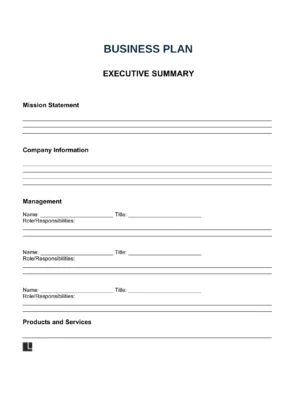
Updated December 8, 2023 Written by Sara Hostelley | Reviewed by Brooke Davis
A business plan is a document outlining a company’s operations, strategies, goals, and objectives. It’s crucial to guide you through each stage of starting and growing your business.
Templates (8)
What is a business plan, why is a business plan essential, components of a business plan, how to write a business plan, business plan sample.
Below, you can find free business plan templates for specific business types. You can also find more in-depth information on writing a plan for your business, whether it’s a food truck, restaurant, real estate business, or another entity:
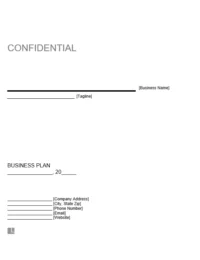
Create a detailed plan that lays out the details of how your business will achieve it's objectives.
Traditional Business Plan
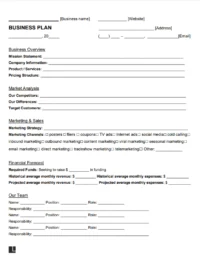
Create a simplified version of a traditional business plan.
One-Page Business Plan
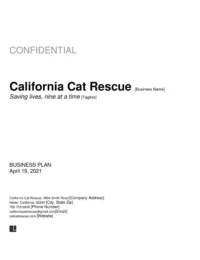
Create a Non-Profit Business Plan and learn how to write one.
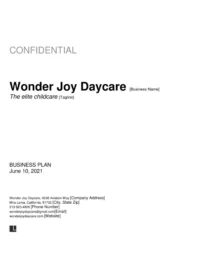
Create a Daycare Business Plan and learn how to write one.

Create a Restaurant Business Plan and learn how to write one.
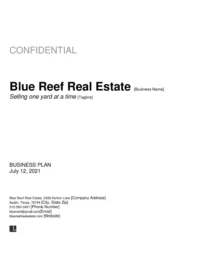
Create a Real Estate Business Plan and learn how to write one.
Real Estate
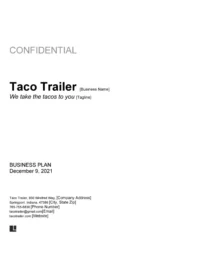
Create a Food Truck Business Plan and learn how to write one.
A business plan is a document detailing how a business, whether it’s a new or existing company, will achieve its goals and objectives. It guides you through every step of starting and running a company.
A business plan can be the foundation of your business, serving as a written roadmap that covers all aspects of how to structure, run, and grow your business. You can also refer back to it as your business progresses to track its growth and success.
In addition to being a helpful document internally, a business plan is also vital for a company to communicate its success to external parties that may influence its future success.
Consider some of the main reasons why large and small business owners alike use business plans:
1. Use As a Roadmap
A business plan sets specific, measurable, and time-bound goals. Having these goals helps you track progress, evaluate performance, and adjust as necessary.
By laying out goals, you have a clear and attainable plan of action with the ability to see and monitor your progress.
2. Plan Strategies For Potential Challenges
A business plan can help you think objectively about your business’s key elements and inform your decision-making as you move forward.
A detailed plan can provide a semblance of control over a potentially cumbersome process. Formulating a plan can improve your ability to make choices and decisions for yourself and the business. This approach is much better than suddenly making a critical decision without time to evaluate or haphazardly letting others decide for you.
3. Get Funding or Bring on New Business Partners
An accurate business plan is essential whether or not you need to secure a business loan. Investors and lenders often require a business plan before they commit capital. A solid plan demonstrates your commitment, viability, and potential return on investment.
Create a business plan that grabs the attention of potential investors and provides them with enough structure and confidence that they will move forward and grant funding and support to your business.
You can use your business plan to highlight how the proposed business will be successful and profitable.
4. Discover Any Weaknesses
A business plan includes a strengths, weaknesses, opportunities, and threats (SWOT) analysis that helps identify potential risks and challenges. It is essential to allocate resources and demonstrate monthly profit or loss. By recognizing these elements early, you can develop strategies to mitigate or address them.
5. Analyze the Market and Competition
Market research within the plan helps you better understand your target audience, competition, and industry trends. This knowledge is crucial for making informed business decisions.
By learning about your competition, you can help make your goods or services stand out and help validate your business idea.
You should update a business plan as you go, altering your goals as necessary and being mindful of any changes of direction in your business.
A typical business plan includes the following sections:
- Executive Summary
- Management Team
- Products and Services
- Customers and Marketing
- SWOT Analysis
Our business plan template includes all of the above, so you won’t have to worry about missing out on essential sections.
Step 1 – Create an Executive Summary
An executive summary is the first section of a traditional business plan, serving as the first impression of your business. Please give a brief overview of your company, including its mission, key goals, and a snapshot of your financial projections.
You can skip this step if you’re writing a lean business plan for a startup. Instead, replace it with a few sentences outlining the problem your startup aims to solve and the solution you will provide.
Executive Summary Example:
Market research indicates there are a growing number of dog owners in Tallahassee who want to train their animals. Consumer surveys indicate that most consumers don’t have the time or resources to train their animals themselves.
Consumers have also expressed a desire for combined dog walking and training services to help discipline their animals.
Pawsitive Strides Canine Coaching & Walks provides a convenient service for customers with furry friends and disposable incomes.
Tips for Writing an Executive Summary
- Define a problem in your market and state how your business will solve it.
- Limit your executive summary to one page.
- Use a tone appropriate for your audience.
Step 2 – Describe Your Company’s Team
A professional business plan will include a statement about your company’s team and management.
Describe your startup’s legal structure. After that, you can insert a chart to show the hierarchical structure of your company. Show and name your C-suite executives, management team, and key employees. Include short biographies and links to their resumes and LinkedIn profiles to give the reader a complete picture of your staff’s qualifications.
If you have a smaller staff, you can highlight the founder and CEO and your staff members who perform the services or create your business’s products.
Example for Company’s Team Statement:
Jamie Clayton, Founder and CEO
- Board-certified veterinarian.
Pawsitive Strides Canine Coaching & Walks’s dog walkers and trainers
- 14 full-time staff members.
- 26 part-time staff members.
- All staff members have the Certified Professional Dog Trainer-Knowledge and Skills Assessed (CPDT-KSA) credential from the Certification Council for Professional Dog Trainers.
Tips for Writing about Your Company Management and Team
- Include any roles you’d like to hire to grow your company, if applicable.
- Highlight expertise and awards one to show your staff’s capabilities.
Step 3 – Summarize Market Analysis and Potential
Your business plan must also thoroughly analyze your target market and customer base. The goal here is to show that you understand your market and target audience and that there is a viable market for your business.
Market Analysis Example:
Pawsitive Strides Canine Coaching & Walks’s ideal customer is a dog owner between the ages of 25 and 65 with a high disposable income. They’re ideally a working professional or have recently retired from the workplace. They love their dog (or dogs) and want them to be well-behaved and have an outlet for all their energy.
Market research shows that Pawsitive Strides Canine Coaching & Walks has ample opportunities in the Tallahassee area:
- The total revenue for dog walking services in the U.S. increased from $900 million in 2019 to $1.1 billion in 2023.
- Dog ownership has increased by 20% over the last five years.
- Online search volume for “dog walkers in Tallahassee” is up by 10% since last year.
- 19% of Tallahassee’s residents have a household income of $125,000 or more (compared to the average of 5% across the U.S.).
Tips for Writing a Market Analysis
- Use reliable sources for acquiring data.
- Conduct consumer surveys to hear from people in your target area.
- Focus on the demand in your area and the growth potential.
- Include revenue and expense projections based on market data.
Step 4 – Describe Your Product or Service
Describe the products and services you offer. Pinpoint the value they provide to current and future customers and share your plans for research and development.
The main goal of this section is to convince the reader and yourself that your business is viable and that you have enough resources, time, and energy to achieve your goals.
Product Description Example:
Pawsitive Strides Canine Coaching & Walks isn’t an ordinary dog walking service. When a customer signs up for our monthly subscription plan, we have one of our certified dog walkers go to their house 12 times a month on a schedule that works for them.
Our dog walker takes their dog on a 30-minute walk and corrects their behavior. Their dog learns how to walk on a leash calmly and be around cars and people. Not only does the dog get some exercise and fresh air, but they also learn discipline, meaning the customer doesn’t have to worry about training their dog in this sense.
Tips for Writing a Product/Service Description
- Highlight cross-sell and upsell opportunities, if applicable.
- Emphasize what distinguishes you from other companies providing similar services/products.
- Include details for updating your offerings in the future.
Step 5 – Plan Your Marketing Strategy
Discuss the brand vision you want to cultivate, the metrics you’ll track, and the channels you’ll use to reach your target audience. Outlining how you plan to collect and retain customers will help you experience growth in the long term.
Marketing Strategy Example:
Pawsitive Strides Canine Coaching & Walks will focus on social media and direct mail marketing as its two main forms of advertising. We’ll track customer referrals to determine how many current customers are satisfied with our services.
On our social media platforms, including Instagram and Facebook, we’ll track our audience growth rate, bounce rate, and click-through rate.
Tips for Writing a Marketing Strategy
- Add the budget/resources you have, if applicable.
- Create strategies for marketing to different segments within your main target audience.
Step 6 – Conduct SWOT Analysis
Organizations use SWOT analyses to determine how closely a business will adhere to its growth trajectories. This analysis involves looking at a company’s SWOTs, which are:
- Strengths: Strengths are things your company does well. Examples include having a unique selling proposition, standout brandings, or human resources, like your employees and C-class executives.
- Weaknesses: These barriers prevent your project or company from reaching certain milestones. Examples include financial limitations, a shortage of skilled professionals, and unclear selling propositions.
- Opportunities: These positive external factors could give you a competitive edge. For instance, if you’re a manufacturer and the federal government cuts tariffs, you can export your products into a new market to boost market share and sales.
- Threats: These are events, competitors, and situations that pose a risk to your company and the goals you’ve set for it. Typical threats include negative media coverage, changing customer demands, emerging competitors, and new rules and regulations.
SWOT Analysis Example:
- Appeals to people who don’t have the time or resources to train their pets.
- Low startup costs.
- Finding enough certified employees to meet the anticipated demand.
- Dealing with aggressive animals may be challenging for newer employees.
Opportunities
- Offering multiple subscription packages for customers who want more frequent training sessions for their pets.
- BehaviorBuddies is a dog walking service in Bradfordville that may take away customers.
Tips for Writing a SWOT Analysis
- Be honest with your business’s weaknesses and threats.
- Capitalize on opportunities you find through market analysis.
Step 7 – Develop a Strategy for Operations
Your business plan needs to include a thorough operations plan. This section reveals your manufacturing, fulfillment, managing, staffing, hiring strategies, and all the other processes you go through when running your business daily.
Operations Strategy Example:
Jamie Clayton will oversee the hiring of all employees, and the team lead will train all employees for at least one month to ensure they have the knowledge necessary to deal with animals of all temperaments.
The team lead will also organize the dog walking schedule to ensure all team members have enough time to arrive at customers’ houses and complete the dog walking/training sessions thoroughly.
Tips for Writing a Business Strategy
- Consider what your business needs to thrive on a daily basis.
- Account for inventory and supplies, even if your business is service-based.
Step 8 – Compile Your Business Financials
Create financial projections, including income statements, balance sheets, and cash flow statements for the first few years of operation. If you need funding, specify the amount and how you plan to use it.
Financial Statement Example:
Income Statement for the Year Ended December 31, 2023
- Revenue: $150,000
- Cost of Goods Sold: $30,000
- Gross Profit: $120,000
- Operating Expenses: $80,000
- Net Operating Income: $40,000
- Other Income/Expenses: -$2,000
- Net Income: $38,000
Tips for Writing a Financial Section
- Double-check the accuracy of financial information.
- Demonstrate how the proposed funding aligns with your company’s goals.
- Forecast future financial performance.
Step 9 – Explain Your Funding Request
If you’re seeking funding or investment for your business, explain the amount you need and how you intend to use it. Be transparent about the terms you’re offering to investors or lenders.
Funding Request Example:
Pawsitive Strides Canine Coaching & Walks has already hired a team to serve our existing customers. Once we scale to $500,000 in annual revenue over the next two years and at a 10% profit margin, our primary ongoing annual expenses (not including taxes) will total $350,000.
While already profitable, we are requesting $200,000 in the form of a business loan to buy two additional company vehicles. These vehicles will improve our employees’ ability to get to customers’ homes, and the remaining money will go toward maintaining current company vehicles.
Tips for Writing a Funding Request
- Add a timeline so investors know your goals and how you plan to use the money.
- If you seek funding in the form of an exchange for equity, an investor may expect to gain decision-making powers in your company. Plan for this situation accordingly.
Step 10 – Compile an Appendix for Official Documents
Include relevant documents, such as resumes of key team members, legal agreements, market research data, product design mock-ups, and your business’s legal structure documents.
Remember that each business plan is unique, so tailor your content to your venture and audience. Your business plan should effectively communicate your vision, strategy, and financial viability to potential investors, partners, and stakeholders.
Combine the appendix with a table of contents and footnotes section so you can reference it throughout your document.
You can download a free business plan template below in PDF or Word format:
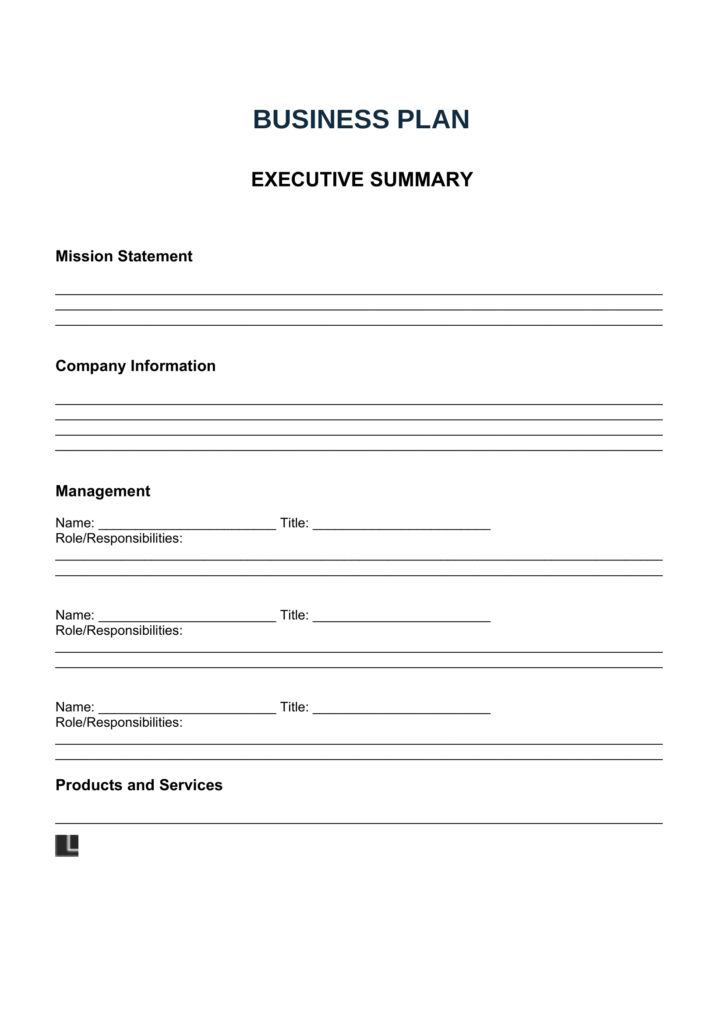
Related Documents
- Business Continuity Plan : Outline how your business will run in the event of a range of disaster scenarios with a business continuity plan.
- One-Page Business Plan : A simplified version of a traditional business plan that outlines the basics of your business.
- LLC Operating Agreement : An internal written document among members of a Limited Liability Company (“LLC”).
- Business Proposal : Use this document to form new relationships with other businesses and organizations.
- Request for Proposal : Download this form to allow you to collect offers from various vendors who can provide goods or services your business needs.
- Legal Resources
- Partner With Us
- Terms of Use
- Privacy Policy
- Do Not Sell My Personal Information

The document above is a sample. Please note that the language you see here may change depending on your answers to the document questionnaire.
Thank you for downloading!
How would you rate your free template?
Click on a star to rate
- Build your business
Business Tools
- Profit Margin Calculator
- Business Name Generator
- Slogan Generator
- Traffic Calculator
- Ecommerce Statistics
- Ecommerce Wiki
Free business tools
Start a business and design the life you want – all in one place.
- © 2015-2024 Oberlo

The 7 Best Business Plan Examples (2024)
As an aspiring entrepreneur gearing up to start your own business , you likely know the importance of drafting a business plan. However, you might not be entirely sure where to begin or what specific details to include. That’s where examining business plan examples can be beneficial. Sample business plans serve as real-world templates to help you craft your own plan with confidence. They also provide insight into the key sections that make up a business plan, as well as demonstrate how to structure and present your ideas effectively.
Example business plan
To understand how to write a business plan, let’s study an example structured using a seven-part template. Here’s a quick overview of those parts:
- Executive summary: A quick overview of your business and the contents of your business plan.
- Company description: More info about your company, its goals and mission, and why you started it in the first place.
- Market analysis: Research about the market and industry your business will operate in, including a competitive analysis about the companies you’ll be up against.
- Products and services: A detailed description of what you’ll be selling to your customers.
- Marketing plan: A strategic outline of how you plan to market and promote your business before, during, and after your company launches into the market.
- Logistics and operations plan: An explanation of the systems, processes, and tools that are needed to run your business in the background.
- Financial plan: A map of your short-term (and even long-term) financial goals and the costs to run the business. If you’re looking for funding, this is the place to discuss your request and needs.
7 business plan examples (section by section)
In this section, you’ll find hypothetical and real-world examples of each aspect of a business plan to show you how the whole thing comes together.
- Executive summary
Your executive summary offers a high-level overview of the rest of your business plan. You’ll want to include a brief description of your company, market research, competitor analysis, and financial information.
In this free business plan template, the executive summary is three paragraphs and occupies nearly half the page:
- Company description
You might go more in-depth with your company description and include the following sections:
- Nature of the business. Mention the general category of business you fall under. Are you a manufacturer, wholesaler, or retailer of your products?
- Background information. Talk about your past experiences and skills, and how you’ve combined them to fill in the market.
- Business structure. This section outlines how you registered your company —as a corporation, sole proprietorship, LLC, or other business type.
- Industry. Which business sector do you operate in? The answer might be technology, merchandising, or another industry.
- Team. Whether you’re the sole full-time employee of your business or you have contractors to support your daily workflow, this is your chance to put them under the spotlight.
You can also repurpose your company description elsewhere, like on your About page, Instagram page, or other properties that ask for a boilerplate description of your business. Hair extensions brand Luxy Hair has a blurb on it’s About page that could easily be repurposed as a company description for its business plan.

- Market analysis
Market analysis comprises research on product supply and demand, your target market, the competitive landscape, and industry trends. You might do a SWOT analysis to learn where you stand and identify market gaps that you could exploit to establish your footing. Here’s an example of a SWOT analysis for a hypothetical ecommerce business:

You’ll also want to run a competitive analysis as part of the market analysis component of your business plan. This will show you who you’re up against and give you ideas on how to gain an edge over the competition.
- Products and services
This part of your business plan describes your product or service, how it will be priced, and the ways it will compete against similar offerings in the market. Don’t go into too much detail here—a few lines are enough to introduce your item to the reader.
- Marketing plan
Potential investors will want to know how you’ll get the word out about your business. So it’s essential to build a marketing plan that highlights the promotion and customer acquisition strategies you’re planning to adopt.
Most marketing plans focus on the four Ps: product, price, place, and promotion. However, it’s easier when you break it down by the different marketing channels . Mention how you intend to promote your business using blogs, email, social media, and word-of-mouth marketing.
Here’s an example of a hypothetical marketing plan for a real estate website:

Logistics and operations
This section of your business plan provides information about your production, facilities, equipment, shipping and fulfillment, and inventory.
Financial plan
The financial plan (a.k.a. financial statement) offers a breakdown of your sales, revenue, expenses, profit, and other financial metrics. You’ll want to include all the numbers and concrete data to project your current and projected financial state.
In this business plan example, the financial statement for ecommerce brand Nature’s Candy includes forecasted revenue, expenses, and net profit in graphs.

It then goes deeper into the financials, citing:
- Funding needs
- Project cash-flow statement
- Project profit-and-loss statement
- Projected balance sheet
You can use Shopify’s financial plan template to create your own income statement, cash-flow statement, and balance sheet.
Types of business plans (and what to write for each)
A one-page business plan is a pared down version of a standard business plan that’s easy for potential investors and partners to understand. You’ll want to include all of these sections, but make sure they’re abbreviated and summarized:
- Logistics and operations plan
- Financials
A startup business plan is meant to secure outside funding for a new business. Typically, there’s a big focus on the financials, as well as other sections that help determine the viability of your business idea—market analysis, for example. Shopify has a great business plan template for startups that include all the below points:
- Market research: in depth
- Financials: in depth
Your internal business plan acts as the enforcer of your company’s vision. It reminds your team of the long-term objective and keeps them strategically aligned toward the same goal. Be sure to include:
- Market research
Feasibility
A feasibility business plan is essentially a feasibility study that helps you evaluate whether your product or idea is worthy of a full business plan. Include the following sections:
A strategic (or growth) business plan lays out your long-term vision and goals. This means your predictions stretch further into the future, and you aim for greater growth and revenue. While crafting this document, you use all the parts of a usual business plan but add more to each one:
- Products and services: for launch and expansion
- Market analysis: detailed analysis
- Marketing plan: detailed strategy
- Logistics and operations plan: detailed plan
- Financials: detailed projections
Free business plan templates
Now that you’re familiar with what’s included and how to format a business plan, let’s go over a few templates you can fill out or draw inspiration from.
Bplans’ free business plan template

Bplans’ free business plan template focuses a lot on the financial side of running a business. It has many pages just for your financial plan and statements. Once you fill it out, you’ll see exactly where your business stands financially and what you need to do to keep it on track or make it better.
PandaDoc’s free business plan template

PandaDoc’s free business plan template is detailed and guides you through every section, so you don’t have to figure everything out on your own. Filling it out, you’ll grasp the ins and outs of your business and how each part fits together. It’s also handy because it connects to PandaDoc’s e-signature for easy signing, ideal for businesses with partners or a board.
Miro’s Business Model Canvas Template

Miro’s Business Model Canvas Template helps you map out the essentials of your business, like partnerships, core activities, and what makes you different. It’s a collaborative tool for you and your team to learn how everything in your business is linked.
Better business planning equals better business outcomes
Building a business plan is key to establishing a clear direction and strategy for your venture. With a solid plan in hand, you’ll know what steps to take for achieving each of your business goals. Kickstart your business planning and set yourself up for success with a defined roadmap—utilizing the sample business plans above to inform your approach.
Business plan FAQ
What are the 3 main points of a business plan.
- Concept. Explain what your business does and the main idea behind it. This is where you tell people what you plan to achieve with your business.
- Contents. Explain what you’re selling or offering. Point out who you’re selling to and who else is selling something similar. This part concerns your products or services, who will buy them, and who you’re up against.
- Cash flow. Explain how money will move in and out of your business. Discuss the money you need to start and keep the business going, the costs of running your business, and how much money you expect to make.
How do I write a simple business plan?
To create a simple business plan, start with an executive summary that details your business vision and objectives. Follow this with a concise description of your company’s structure, your market analysis, and information about your products or services. Conclude your plan with financial projections that outline your expected revenue, expenses, and profitability.
What is the best format to write a business plan?
The optimal format for a business plan arranges your plan in a clear and structured way, helping potential investors get a quick grasp of what your business is about and what you aim to achieve. Always start with a summary of your plan and finish with the financial details or any extra information at the end.
Want to learn more?
- Question: Are You a Business Owner or an Entrepreneur?
- Bootstrapping a Business: 10 Tips to Help You Succeed
- Entrepreneurial Mindset: 20 Ways to Think Like an Entrepreneur
- 101+ Best Small Business Software Programs
| You might be using an unsupported or outdated browser. To get the best possible experience please use the latest version of Chrome, Firefox, Safari, or Microsoft Edge to view this website. |
How To Start A Business In 11 Steps (2024 Guide)

Updated: Apr 7, 2024, 1:44pm

Table of Contents
Before you begin: get in the right mindset, 1. determine your business concept, 2. research your competitors and market, 3. create your business plan, 4. choose your business structure, 5. register your business and get licenses, 6. get your finances in order, 7. fund your business, 8. apply for business insurance, 9. get the right business tools, 10. market your business, 11. scale your business, what are the best states to start a business, bottom line, frequently asked questions (faqs).
Starting a business is one of the most exciting and rewarding experiences you can have. But where do you begin? There are several ways to approach creating a business, along with many important considerations. To help take the guesswork out of the process and improve your chances of success, follow our comprehensive guide on how to start a business. We’ll walk you through each step of the process, from defining your business idea to registering, launching and growing your business.
Featured Partners
ZenBusiness
$0 + State Fees
Varies By State & Package

On ZenBusiness' Website

On LegalZoom's Website
Northwest Registered Agent
$39 + State Fees

On Northwest Registered Agent's Website
The public often hears about overnight successes because they make for a great headline. However, it’s rarely that simple—they don’t see the years of dreaming, building and positioning before a big public launch. For this reason, remember to focus on your business journey and don’t measure your success against someone else’s.
Consistency Is Key
New business owners tend to feed off their motivation initially but get frustrated when that motivation wanes. This is why it’s essential to create habits and follow routines that power you through when motivation goes away.
Take the Next Step
Some business owners dive in headfirst without looking and make things up as they go along. Then, there are business owners who stay stuck in analysis paralysis and never start. Perhaps you’re a mixture of the two—and that’s right where you need to be. The best way to accomplish any business or personal goal is to write out every possible step it takes to achieve the goal. Then, order those steps by what needs to happen first. Some steps may take minutes while others take a long time. The point is to always take the next step.
Most business advice tells you to monetize what you love, but it misses two other very important elements: it needs to be profitable and something you’re good at. For example, you may love music, but how viable is your business idea if you’re not a great singer or songwriter? Maybe you love making soap and want to open a soap shop in your small town that already has three close by—it won’t be easy to corner the market when you’re creating the same product as other nearby stores.
If you don’t have a firm idea of what your business will entail, ask yourself the following questions:
- What do you love to do?
- What do you hate to do?
- Can you think of something that would make those things easier?
- What are you good at?
- What do others come to you for advice about?
- If you were given ten minutes to give a five-minute speech on any topic, what would it be?
- What’s something you’ve always wanted to do, but lacked resources for?
These questions can lead you to an idea for your business. If you already have an idea, they might help you expand it. Once you have your idea, measure it against whether you’re good at it and if it’s profitable.
Your business idea also doesn’t have to be the next Scrub Daddy or Squatty Potty. Instead, you can take an existing product and improve upon it. You can also sell a digital product so there’s little overhead.
What Kind of Business Should You Start?
Before you choose the type of business to start, there are some key things to consider:
- What type of funding do you have?
- How much time do you have to invest in your business?
- Do you prefer to work from home or at an office or workshop?
- What interests and passions do you have?
- Can you sell information (such as a course), rather than a product?
- What skills or expertise do you have?
- How fast do you need to scale your business?
- What kind of support do you have to start your business?
- Are you partnering with someone else?
- Does the franchise model make more sense to you?
Consider Popular Business Ideas
Not sure what business to start? Consider one of these popular business ideas:
- Start a Franchise
- Start a Blog
- Start an Online Store
- Start a Dropshipping Business
- Start a Cleaning Business
- Start a Bookkeeping Business
- Start a Clothing Business
- Start a Landscaping Business
- Start a Consulting Business
- Start a Photography Business
- Start a Vending Machine Business
Most entrepreneurs spend more time on their products than they do getting to know the competition. If you ever apply for outside funding, the potential lender or partner wants to know: what sets you (or your business idea) apart? If market analysis indicates your product or service is saturated in your area, see if you can think of a different approach. Take housekeeping, for example—rather than general cleaning services, you might specialize in homes with pets or focus on garage cleanups.
Primary Research
The first stage of any competition study is primary research, which entails obtaining data directly from potential customers rather than basing your conclusions on past data. You can use questionnaires, surveys and interviews to learn what consumers want. Surveying friends and family isn’t recommended unless they’re your target market. People who say they’d buy something and people who do are very different. The last thing you want is to take so much stock in what they say, create the product and flop when you try to sell it because all of the people who said they’d buy it don’t because the product isn’t something they’d buy.
Secondary Research
Utilize existing sources of information, such as census data, to gather information when you do secondary research. The current data may be studied, compiled and analyzed in various ways that are appropriate for your needs but it may not be as detailed as primary research.
Conduct a SWOT Analysis
SWOT stands for strengths, weaknesses, opportunities and threats. Conducting a SWOT analysis allows you to look at the facts about how your product or idea might perform if taken to market, and it can also help you make decisions about the direction of your idea. Your business idea might have some weaknesses that you hadn’t considered or there may be some opportunities to improve on a competitor’s product.

Asking pertinent questions during a SWOT analysis can help you identify and address weaknesses before they tank your new business.
A business plan is a dynamic document that serves as a roadmap for establishing a new business. This document makes it simple for potential investors, financial institutions and company management to understand and absorb. Even if you intend to self-finance, a business plan can help you flesh out your idea and spot potential problems. When writing a well-rounded business plan, include the following sections:
- Executive summary: The executive summary should be the first item in the business plan, but it should be written last. It describes the proposed new business and highlights the goals of the company and the methods to achieve them.
- Company description: The company description covers what problems your product or service solves and why your business or idea is best. For example, maybe your background is in molecular engineering, and you’ve used that background to create a new type of athletic wear—you have the proper credentials to make the best material.
- Market analysis: This section of the business plan analyzes how well a company is positioned against its competitors. The market analysis should include target market, segmentation analysis, market size, growth rate, trends and a competitive environment assessment.
- Organization and structure: Write about the type of business organization you expect, what risk management strategies you propose and who will staff the management team. What are their qualifications? Will your business be a single-member limited liability company (LLC) or a corporation ?
- Mission and goals: This section should contain a brief mission statement and detail what the business wishes to accomplish and the steps to get there. These goals should be SMART (specific, measurable, action-orientated, realistic and time-bound).
- Products or services: This section describes how your business will operate. It includes what products you’ll offer to consumers at the beginning of the business, how they compare to existing competitors, how much your products cost, who will be responsible for creating the products, how you’ll source materials and how much they cost to make.
- Background summary: This portion of the business plan is the most time-consuming to write. Compile and summarize any data, articles and research studies on trends that could positively and negatively affect your business or industry.
- Marketing plan: The marketing plan identifies the characteristics of your product or service, summarizes the SWOT analysis and analyzes competitors. It also discusses how you’ll promote your business, how much money will be spent on marketing and how long the campaign is expected to last.
- Financial plan: The financial plan is perhaps the core of the business plan because, without money, the business will not move forward. Include a proposed budget in your financial plan along with projected financial statements, such as an income statement, a balance sheet and a statement of cash flows. Usually, five years of projected financial statements are acceptable. This section is also where you should include your funding request if you’re looking for outside funding.
Learn more: Download our free simple business plan template .
Come Up With an Exit Strategy
An exit strategy is important for any business that is seeking funding because it outlines how you’ll sell the company or transfer ownership if you decide to retire or move on to other projects. An exit strategy also allows you to get the most value out of your business when it’s time to sell. There are a few different options for exiting a business, and the best option for you depends on your goals and circumstances.
The most common exit strategies are:
- Selling the business to another party
- Passing the business down to family members
- Liquidating the business assets
- Closing the doors and walking away
Develop a Scalable Business Model
As your small business grows, it’s important to have a scalable business model so that you can accommodate additional customers without incurring additional costs. A scalable business model is one that can be replicated easily to serve more customers without a significant increase in expenses.
Some common scalable business models are:
- Subscription-based businesses
- Businesses that sell digital products
- Franchise businesses
- Network marketing businesses
Start Planning for Taxes
One of the most important things to do when starting a small business is to start planning for taxes. Taxes can be complex, and there are several different types of taxes you may be liable for, including income tax, self-employment tax, sales tax and property tax. Depending on the type of business you’re operating, you may also be required to pay other taxes, such as payroll tax or unemployment tax.
Start A Limited Liability Company Online Today with ZenBusiness
Click to get started.
When structuring your business, it’s essential to consider how each structure impacts the amount of taxes you owe, daily operations and whether your personal assets are at risk.
An LLC limits your personal liability for business debts. LLCs can be owned by one or more people or companies and must include a registered agent . These owners are referred to as members.
- LLCs offer liability protection for the owners
- They’re one of the easiest business entities to set up
- You can have a single-member LLC
- You may be required to file additional paperwork with your state on a regular basis
- LLCs can’t issue stock
- You’ll need to pay annual filing fees to your state
Limited Liability Partnership (LLP)
An LLP is similar to an LLC but is typically used for licensed business professionals such as an attorney or accountant. These arrangements require a partnership agreement.
- Partners have limited liability for the debts and actions of the LLP
- LLPs are easy to form and don’t require much paperwork
- There’s no limit to the number of partners in an LLP
- Partners are required to actively take part in the business
- LLPs can’t issue stock
- All partners are personally liable for any malpractice claims against the business
Sole Proprietorship
If you start a solo business, you might consider a sole proprietorship . The company and the owner, for legal and tax purposes, are considered the same. The business owner assumes liability for the business. So, if the business fails, the owner is personally and financially responsible for all business debts.
- Sole proprietorships are easy to form
- There’s no need to file additional paperwork with your state
- You’re in complete control of the business
- You’re personally liable for all business debts
- It can be difficult to raise money for a sole proprietorship
- The business may have a limited lifespan
Corporation
A corporation limits your personal liability for business debts just as an LLC does. A corporation can be taxed as a C corporation (C-corp) or an S corporation (S-corp). S-corp status offers pass-through taxation to small corporations that meet certain IRS requirements. Larger companies and startups hoping to attract venture capital are usually taxed as C-corps.
- Corporations offer liability protection for the owners
- The life span of a corporation is not limited
- A corporation can have an unlimited number of shareholders
- Corporations are subject to double taxation
- They’re more expensive and complicated to set up than other business structures
- The shareholders may have limited liability
Before you decide on a business structure, discuss your situation with a small business accountant and possibly an attorney, as each business type has different tax treatments that could affect your bottom line.
Helpful Resources
- How To Set Up an LLC in 7 Steps
- How To Start a Sole Proprietorship
- How To Start a Corporation
- How To Start a Nonprofit
- How To Start a 501(c)(3)
There are several legal issues to address when starting a business after choosing the business structure. The following is a good checklist of items to consider when establishing your business:
Choose Your Business Name
Make it memorable but not too difficult. Choose the same domain name, if available, to establish your internet presence. A business name cannot be the same as another registered company in your state, nor can it infringe on another trademark or service mark that is already registered with the United States Patent and Trademark Office (USPTO).
Business Name vs. DBA
There are business names, and then there are fictitious business names known as “Doing Business As” or DBA. You may need to file a DBA if you’re operating under a name that’s different from the legal name of your business. For example, “Mike’s Bike Shop” is doing business as “Mike’s Bikes.” The legal name of the business is “Mike’s Bike Shop,” and “Mike’s Bikes” is the DBA.
You may need to file a DBA with your state, county or city government offices. The benefits of a DBA include:
- It can help you open a business bank account under your business name
- A DBA can be used as a “trade name” to brand your products or services
- A DBA can be used to get a business license
Register Your Business and Obtain an EIN
You’ll officially create a corporation, LLC or other business entity by filing forms with your state’s business agency―usually the Secretary of State. As part of this process, you’ll need to choose a registered agent to accept legal documents on behalf of your business. You’ll also pay a filing fee. The state will send you a certificate that you can use to apply for licenses, a tax identification number (TIN) and business bank accounts.
Next, apply for an employer identification number (EIN) . All businesses, other than sole proprietorships with no employees, must have a federal employer identification number. Submit your application to the IRS and you’ll typically receive your number in minutes.
Get Appropriate Licenses and Permits
Legal requirements are determined by your industry and jurisdiction. Most businesses need a mixture of local, state and federal licenses to operate. Check with your local government office (and even an attorney) for licensing information tailored to your area.
- Best LLC Services
- How To Register a Business Name
- How To Register a DBA
- How To Get an EIN for an LLC
- How To Get a Business License
Start an LLC Online Today With ZenBusiness
Click on the state below to get started.
Open a Business Bank Account
Keep your business and personal finances separate. Here’s how to choose a business checking account —and why separate business accounts are essential. When you open a business bank account, you’ll need to provide your business name and your business tax identification number (EIN). This business bank account can be used for your business transactions, such as paying suppliers or invoicing customers. Most times, a bank will require a separate business bank account to issue a business loan or line of credit.
Hire a Bookkeeper or Get Accounting Software
If you sell a product, you need an inventory function in your accounting software to manage and track inventory. The software should have ledger and journal entries and the ability to generate financial statements.
Some software programs double as bookkeeping tools. These often include features such as check writing and managing receivables and payables. You can also use this software to track your income and expenses, generate invoices, run reports and calculate taxes.
There are many bookkeeping services available that can do all of this for you, and more. These services can be accessed online from any computer or mobile device and often include features such as bank reconciliation and invoicing. Check out the best accounting software for small business, or see if you want to handle the bookkeeping yourself.
Determine Your Break-Even Point
Before you fund your business, you must get an idea of your startup costs. To determine these, make a list of all the physical supplies you need, estimate the cost of any professional services you will require, determine the price of any licenses or permits required to operate and calculate the cost of office space or other real estate. Add in the costs of payroll and benefits, if applicable.
Businesses can take years to turn a profit, so it’s better to overestimate the startup costs and have too much money than too little. Many experts recommend having enough cash on hand to cover six months of operating expenses.
When you know how much you need to get started with your business, you need to know the point at which your business makes money. This figure is your break-even point.
In contrast, the contribution margin = total sales revenue – cost to make product
For example, let’s say you’re starting a small business that sells miniature birdhouses for fairy gardens. You have determined that it will cost you $500 in startup costs. Your variable costs are $0.40 per birdhouse produced, and you sell them for $1.50 each.
Let’s write these out so it’s easy to follow:







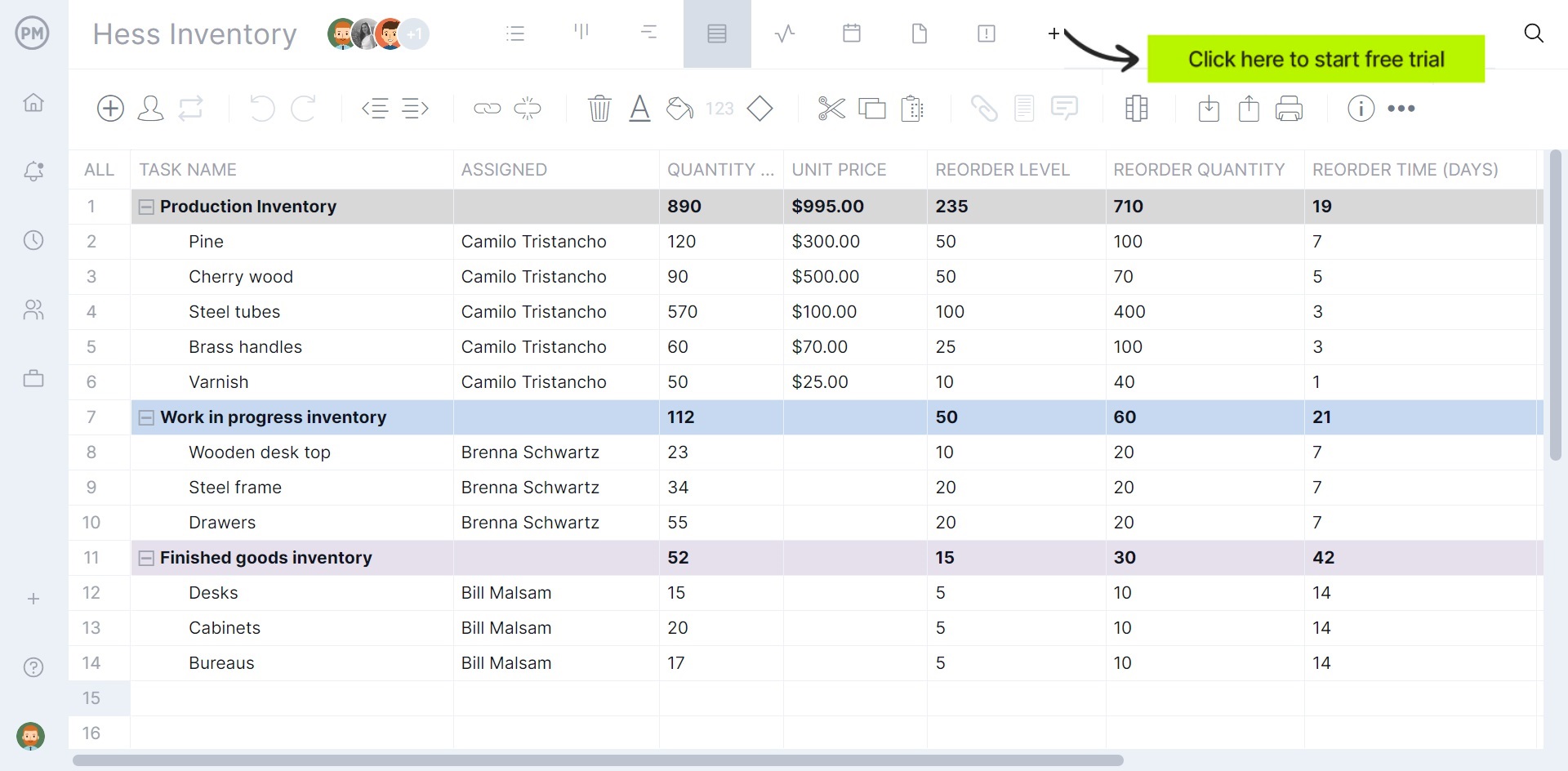


COMMENTS
Manufacturing Business Plan PDF Example. Creating a comprehensive business plan is crucial for launching and running a successful manufacturing business. This plan serves as your roadmap, detailing your vision, operational strategies, and financial plan. It helps establish your manufacturing business's identity, navigate the competitive ...
Use this manufacturing business plan as your template to start and grow your manufacturing company. This business plan for a manufacturing company includes market analysis, strategy, and more. Download this Manufacturing Business Plan free for easy editing in Microsoft Word, Google Docs or Apple Pages to make a PDF:
Get access to Upmetrics software, invite your team members and start writing your business plan. 1. Get tried and tested tips. Upmetrics business plan builder gives you everything you need to stay in sync and guides you on every step of your business plan writing. 3. Stunning business plan cover pages.
As a manufacturing business, you will include your cost of production, the number of units you'll have to sell to reach the break-even point, and how you will optimize the production cost and other miscellaneous costs to make your business a profitable one. To create automatic financials for your own business plan, we recommend Upmetrics.
The capital will be used for funding capital expenditures, salaries, marketing expenses, and working capital. Specifically, these funds will be used as follows: Manufacturing facility design/build-out: $400,000. Equipment and supplies: $375,000. Initial inventory: $100,000. Three months of overhead expenses (payroll, rent, utilities): $250,000.
15+ Manufacturing Business Plan Templates. If you're striking out on your own to start a business, whatever sort it might be, you will benefit from having a business plan template to work from. Such a tool will aid you in your crucial planning and takeoff stages. But there's more to a business than getting started, and how you proceed from there will largely grow out of the conditions you ...
Next, provide an overview of each of the subsequent sections of your plan. For example, give a brief overview of the manufacturing industry. Discuss the type of manufacturing business you are operating. Detail your direct competitors. Give an overview of your target market. Provide a snapshot of your marketing strategy.
Use this free manufacturing business plan template to easily create a great business plan to start or grow your business. Food & Retail Business Plan Templates; ... Once you create your plan, download it to PDF to show banks and investors. I. Executive Summary II. Company Overview III. Industry Analysis IV. Customer Analysis V. Competitive Analysis
If you're planning to start a manufacturing, fabrication, or production business you'll need a business plan to do it. To help you get started, check out our library of sample plans to be sure you're covering everything from sourcing your raw materials to budgeting for plant and equipment.
Get access to Upmetrics software, invite your team members and start writing your business plan. 1. Get tried and tested tips. Upmetrics business plan builder gives you everything you need to stay in sync and guides you on every step of your business plan writing. 3. Stunning business plan cover pages.
To help you get started we've created an example business plan for the manufacturing industry. Our example focuses on producing high quality leather accessories, but it will work as a framework regardless of the specific business you are considering. Click the Download button to gain access to the word document. Good luck and happy writing!
This library of manufacturing and wholesale business plan examples here can inspire and guide you as you begin to plan your business. So, don't worry; we got you covered on that part. Let's learn more about these manufacturing business plan samples, starting with their benefits. Benefits of using an industry-specific business plan example
6. Real-time and Collaborative. Invite your team members to initiate conversations, discuss ideas and strategies in real-time, share respective feedback, and write your business plan. Join over 100k+ entrepreneurs who have used Upmetrics to create their business plans. Start writing your business plan today.
Download Manufacturing Business Plan Sample in pdf. Illustrative business plan samples . OGSCapital's team has assisted thousands of entrepreneurs with top-rate business plan development, consultancy and analysis. They've helped thousands of SME owners secure more than $1.5 billion in funding, and they can do the same for you. ...
7.2 Break-even Analysis. As the business settles in and start-up/showroom costs are met, average monthly operating costs will increase and then stabilize. The average per unit price is for a 24″ base unit. This table shows we need to sell 16 units or 32 lineal feet of cabinets a month to break even.
As the industrial Products and Services Division is a manufacturing setting, this business plan reflects the development of a large amount of hard, non-cash assets, excluding ending year 5 receivables. A full depreciation schedule and payment schedule is included to depreciate the long-term assets.
Starting a manufacturing business is not a decision to be taken lightly . It involves a substantial commitment . Often, manufacturing calls for a heavy up-front financial ... will need this information when executing your business plan, getting financing and generating sales . A big part of your financial commitment is going to
If you are planning to start a new furniture manufacturing business, the first thing you will need is a business plan. Use our sample furniture manufacturing business plan created using Upmetrics business plan software to start writing your business plan in no time.. Before you start writing your business plan for your new graphic design business, spend as much time as you can reading through ...
The global textile manufacturing industry is a multi-billion dollar market. According to a report by Mordor Intelligence: The Textile Market size is estimated at USD 748 billion in 2024. It is expected to reach USD 889.24 billion by 2029. The CAGR is estimated to be 3.52% during the forecast period (2024-2029)
Shoutmouth Business Plan Example. The business plan example below is for Shoutmouth, a company that enjoyed much success in the early 2000's and which was able to raise funding. While the plan's premise (social networking) is not as unique now as it was then, the format and structure of this business plan still holds. I. Executive Summary
Tracking Device Maker Business Plan. RQM Technologies (RQM) is a start-up company which will develop and distribute miniaturized Personal Locator Devices. There are plenty of emerging and traditional industries in need of equipment manufacturers. Companies that can do it better, faster, cheaper, or more specifically to suit their needs.
Lanzor Medical's Business. We design, develop, and are selling unique solutions for the $4.2 billion global market for catheter-based equipment to diagnose and treat cardiovascular disease. Our clinically proven and FDA and EU approved SmartFlow® products represent the next generation in interventional cardiovascular.
Our business plan template includes all of the above, so you won't have to worry about missing out on essential sections. How to Write a Business Plan Step 1 - Create an Executive Summary. An executive summary is the first section of a traditional business plan, serving as the first impression of your business.
A startup business plan is meant to secure outside funding for a new business. Typically, there's a big focus on the financials, as well as other sections that help determine the viability of your business idea—market analysis, for example. Shopify has a great business plan template for startups that include all the below points: Executive ...
Clothing Manufacturer Business Plan. Looking for the perfect business plan for your new clothing manufacturing business We have created this sample Maxwell Clothes Clothing Manufacturing Business Plan to help you start writing your business plan. With influencer culture and pop culture on a rise, the fashion industry is growing faster than ever.
Learn how to start a business in 11 easy steps with this Forbes guide. Get expert tips on planning, funding, marketing and scaling your venture.
PDF Word EPub Apple Books Kindle; 2024-05: 05/22/2024: Browse FAR Part/Subpart and Download in Various Formats. Parts/Subparts HTML DITA Print ... Part 19 - Small Business Programs Part 20 - Reserved Part 21 - Reserved Part 22 - Application of Labor Laws to Government Acquisitions
The company's goal in the next 2-5 years is to venture into women's and children's clothing. It plans to also license a line of cologne and perfume, bedding, underwear, small leather goods, jewelry, and eyewear. According to Standard & Poor's (S&P's), women's apparel accounted for 52% of total apparel sales in 2015.
To do this, manufacturers must understand what a control plan is, the different types of control plans and the steps to make a control plan for manufacturing. We'll go over that, explain the benefits of a control plan and even link to a free control plan template to help you get started.
UPS Releases 1Q 2024 Earnings. UPS announced first-quarter 2024 consolidated revenues of $21.7 billion, a 5.3% decrease from the first quarter of 2023.